
Past Exhibitions
The Fairfield University Art Museum was formerly known as the Bellarmine Museum of Art, which was founded in 2010. All past exhibitions, including those held at the Walsh Gallery (which was operated independently until 2013) are listed here. To access and download digital materials for exhibitions since 2010 go to the museum’s digital archive.
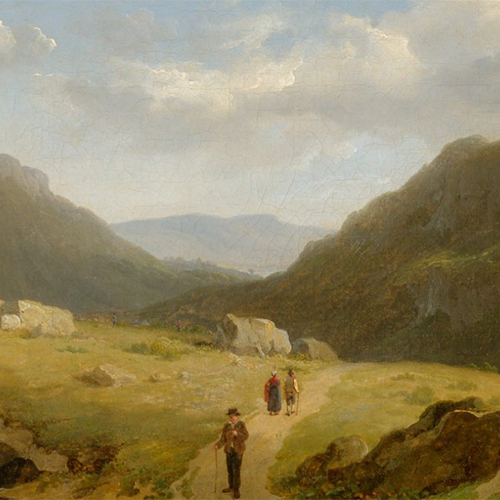
An Gorta Mór: Selections from Ireland's Great Hunger Museum
Walsh Gallery
April 11 – August 16, 2025
Exhibition organized by Quinnipiac University and the Ireland's Great Hunger Museum of Fairfield
This exhibition presents highlights from the collection of Ireland’s Great Hunger Museum, which explores the impact of the Irish Famine of 1845-1852 through artwork produced by eminent Irish and Irish-American artists of the past 170 years. The works on view in the exhibition will include paintings by late 19th- and early 20th‐century artists like James Brenan, Daniel Macdonald, James Arthur O'Connor and Jack B. Yeats, as well as sculptures, paintings, and works on paper by contemporary artists including John Behan, Rowan Gillespie, Brian Maguire, and Hughie O'Donoghue.
James Arthur O’Connor, Scene in Connemara, 1828, oil on canvas. Courtesy of Quinnipiac University and the Ireland’s Great Hunger Museum of Fairfield
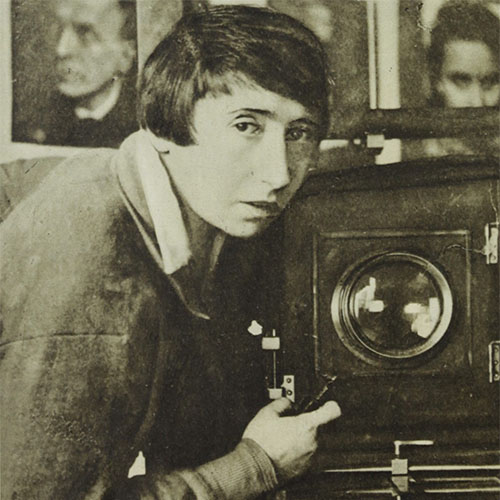
Famous & Family: Through the Lens of Trude Fleischmann
Bellarmine Hall Galleries
May 2 – July 26, 2025
This landmark show will present over 100 photographs by the Austrian-born photographer Trude Fleischmann (1895-1990), one of the most accomplished female photographers of the 20th century. The show, the first solo museum exhibition of the photographer’s work to be presented in the United States, will highlight Fleischmann’s groundbreaking career in Vienna during the 1920s and 1930s, as well as her influential work in the United States after her emigration in 1939.
At just 25 years old, Fleischmann opened her own studio in Vienna and achieved great success as a photographer. She became known for photographing artists, dancers, actors, and other key cultural figures of the era. When the Nazis invaded during the 1938 Anschluss, she fled first to London and then to New York. She opened a studio just behind Carnegie Hall on 56th Street in 1940 and photographed many of the artists and intellectuals of the day, including Eleanor Roosevelt, Marian Anderson, and Albert Einstein.
Lenders to the exhibition include the Wien Museum in Vienna, Austria, the New York Public Library, and private collectors. Importantly, it will also feature never-before-exhibited works from the Fleischmann and Cornides family collections, as well as the family collection of her student and life-long friend, photographer Helen Post (1907-1979). Together, these works provide an unprecedented and intimate view of the photographer’s personal and professional legacy.
Image: Trude Fleischmann, Sandra and Barbara Rosenberg with Golden Heart Necklaces, 1951, gelatin silver print. Courtesy of Barbara Rosenberg Loss. © Trude Fleischmann
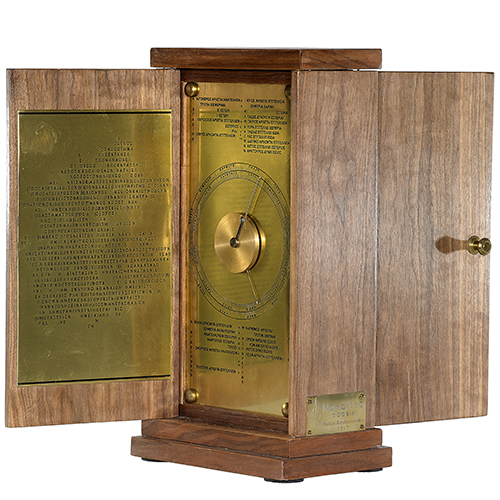
A Model of the Antikythera Mechanism
Bellarmine Hall Galleries
September 12, 2024 - May 23, 2025
The Fairfield University Art Museum is excited to have a model of the Antikythera Mechanism on loan from the Herakleidon Museum in Athens, Greece. The Antikythera Mechanism, often described as the oldest analogue “computer,” was a device dating to the 2nd BCE used for astronomical calculations, including predicting eclipses. Pieces of the bronze device and its wooden case were first discovered in 1901 off the island of Antikythera, from which it takes its name. The pieces are today in the National Archeological Museum of Athens, and scholars continue to study it today to understand its functions.
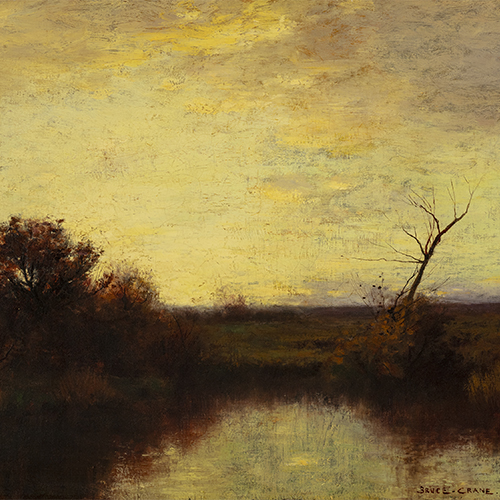
Dawn & Dusk: Tonalism in Connecticut
Bellarmine Hall Galleries
January 17 – April 12, 2025
This exhibition explores Tonalism in the United States from the 1880s to the early 20th century, through artists from the Northeast such as George Inness, John Henry Twachtman, and John Francis Murphy. Tonalism is a transitional movement that grew out of and reacted to the Hudson River School of painting and laid the groundwork for modernism. Evocative landscapes, evoking a spiritual connection to the natural world, often painted from memory, are the primary genre of this movement. The more than fifty artworks in this exhibition are drawn from private and institutional collections.
Image: Bruce Crane, Sunset, n.d., oil on canvas. Private Collection, Connecticut
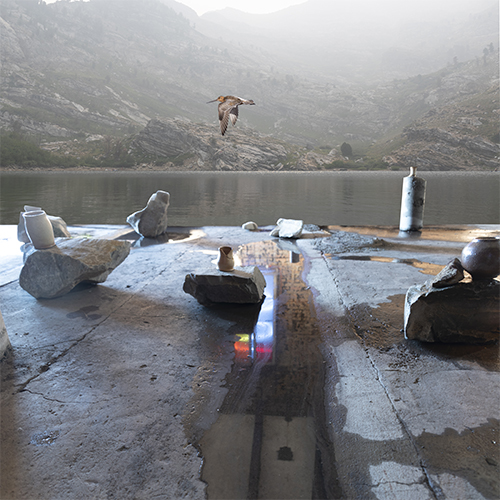
To See This Place: Awakening to Our Common Home
Walsh Gallery
January 24 – March 29, 2025
Environmental threats and climate change are urgent matters of concern at Jesuit universities, where conversations on this topic often take place in reference to two documents by Pope Francis: Laudato Si’: On Care for Our Common Home (2015) and the 2023 update Laudate Deum. Artists play an indispensable role in our collective response to climate change. To See This Place, curated by Al Miner and David Brinker, will present work by Athena LaTocha, Mary Mattingly, and Tyler Rai, three contemporary artists whose outlook resonates with the themes of Laudato Si’ and Laudate Deum. Embodying a breadth of personal, geographic, and cultural backgrounds, the three artists create works strongly associated with a sense of place, whether specific or imaginary. They employ media as diverse as photography, sculpture, video, and painting, and often incorporate materials sourced from particular locales. Yet the artists draw forth broader themes from this particularity, critiquing political and economic systems that perpetuate destructive self-interest and drawing attention to people who have been marginalized and historically excluded or harmed. The works are artistically compelling yet can inspire us to creativity and boldness in our efforts to address climate change.
This exhibition will open at Saint Louis University's Museum of Contemporary Religious Art, Fall 2025.
Image: Mary Mattingly, Saltwater, 2022, chromogenic dye coupler print. Courtesy of the artist © Mary Mattingly
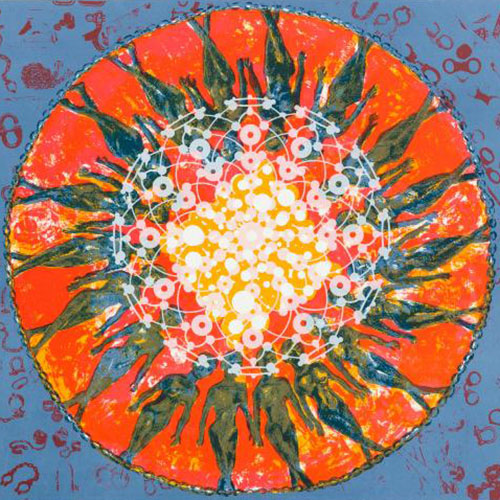
Sacred Space: A Brandywine Workshop and Archives Print Exhibition
Walsh Gallery
September 21 – December 21, 2024
Sacred Space, organized by guest curator Juanita Sunday, draws on the rich history of the Brandywine Workshop and Archives, founded in Philadelphia in 1972 by artist Allan Edmunds. As of 2023, FUAM is home to a Brandywine “satellite collection,” joining other institutions including Harvard Art Museums, RISD Museum, and the University of Delaware Museums. This exhibition features works from FUAM’s own collection as well as loans from Brandywine itself.
Sacred Space encourages a deep exploration of spiritual connection, inviting viewers to reflect on the ancestral wisdom and memory passed down through generations. The exhibition serves as a portal into the interconnected realms of spirituality, time, space, memory, and culture. The artists pay homage to their forebears, drawing upon cultural traditions, rituals, and sacred practices to honor and preserve, as well as question, the invaluable heritage that shapes our identities.
“My belief is that art is best as the articulation of spiritual ideas or transformative intention. It can be an agent of spiritual inspiration or personal and social transformation.” - Michael D. Harris
Image: Mikel Elam, Veil, 2019, offset lithograph and screenprint on paper. Partial gift of the Brandywine Workshop and Archives and Museum Purchase with funds from the Black Art Fund, 2022.17.13
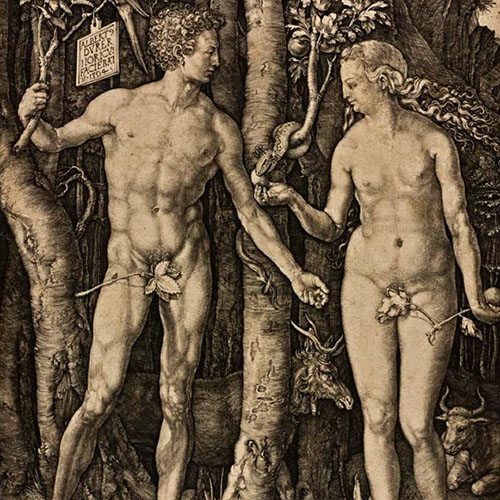
Ink and Time: European Prints from the Wetmore Collection
Bellarmine Hall Galleries
September 12 – December 21, 2024
This exhibition samples the richness of European print culture between the late 15th and late 18th centuries through more than fifty woodcuts, engravings, and etchings, including work by Raphael, Dürer, Rembrandt, and Canaletto. The exhibition explores themes including the collaborative nature of printmaking, the continuing demand for technical innovations, and the problem of “reproductive” prints for the modern viewer.
All of the works in the exhibition are on loan from the Wetmore Collection at Connecticut College. This is the second exhibition to have been curated by Fairfield University students in the Museum Exhibition Seminar, working alongside exhibition curator Michelle DiMarzo, PhD (FUAM Curator of Education and Academic Engagement; Assistant Professor of Art History & Visual Culture, VPA)
Image: Albrecht Dürer, Adam and Eve, 1504, engraving. Courtesy the Wetmore Collection, Connecticut College
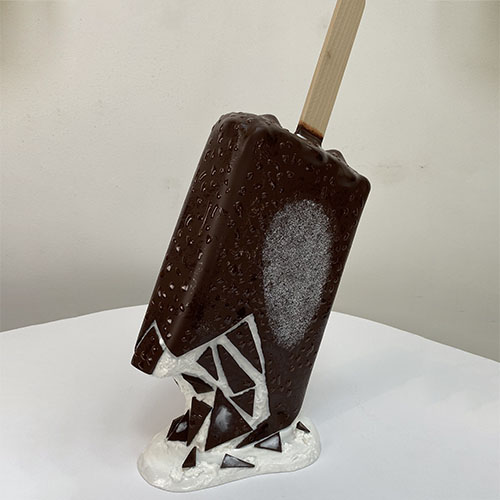
Peter Anton: Just Desserts
Walsh Gallery
May 10 – July 27, 2024
This whimsical exhibition of Peter Anton’s outsized, hyper-realistic sculptures of sweets will include ice cream cones, cakes and confections. Anton has experimented with various methods, including wood, metal, plaster, resin, and oil and acrylic paints to achieve the physicality of his monumental desserts. He chooses subjects that encourage people to think about their own relationship to food, and the memories and nostalgia that these childhood favorites conjure.
Image: Peter Anton, Dark Bar Chaos, © 2021
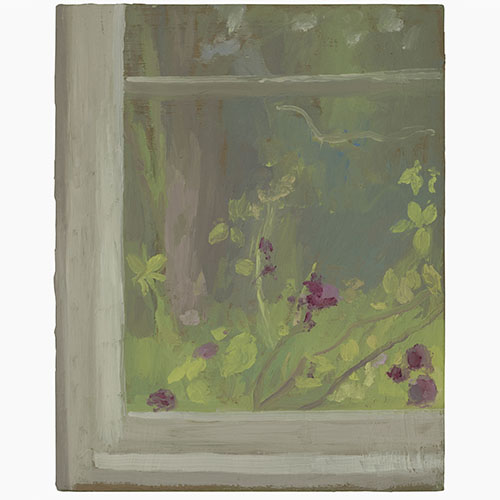
Suzanne Chamlin: Studies in Color
Bellarmine Hall Galleries
April 5 – July 27, 2024
In this exhibition of recent work, Chamlin explores ideas about color theory and light through a series of landscape and interior stills. For each of her paintings, Chamlin sets a highly specific palette; experimentation within this limited range then guides her decisions about process and pictorial space.
Suzanne Chamlin is Associate Professor of Studio Art in the Department of Visual & Performing Arts at Fairfield University. Her drawings are in the collections of the National Gallery of Art, Yale University Art Gallery, and the Nelson Atkins Museum. Chamlin has attended numerous residencies including at the Albers Foundation and Yaddo. Chamlin received her B.A. from Barnard College and M.F.A. from Yale University.
Image: Suzanne Chamlin, Rose Bush Painting, 2019, oil on wood panel. Courtesy of the artist. Photo: Malcolm Varon, NYC
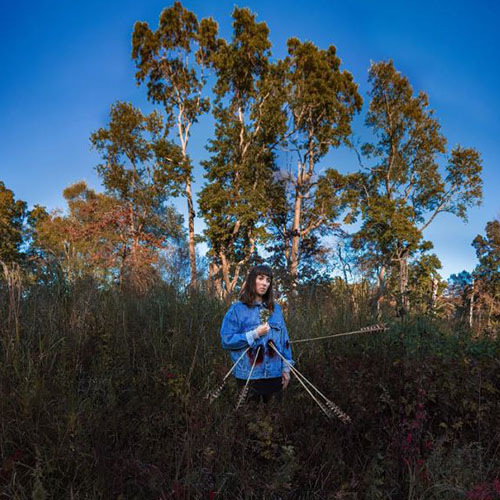
The Landscape in Focus: Recent Acquisitions in Photography
Bellarmine Hall Galleries
April 5 – July 27, 2024
This exhibition of contemporary landscape photography complements the exhibition of paintings by Suzanne Chamlin on view in the Museum’s Meditz Gallery.
In this intimate exhibition, remarkable landscape images share space with photographs which display poignant narratives of human interference with the natural world. Featuring works by Adger Cowans, Jeremy Dennis, Adriana Arenas Ilian, Alen Macweeney, Bea Nettles, Andrea Robbins and Max Becher, Victoria Sambunaris, Larry Silver, James Welling, and Huang Yan, the exhibition includes both color and black-and-white photography, capturing landscapes from the 1960s to the present day, both real and imagined. These recent acquisitions, procured through generous gifts or purchased with funds especially allocated for diversifying the Museum’s permanent collection, invite contemplation on the relationship between humanity and our environment.
Image: Jeremy Dennis, "Nothing Happened Here #11," 2016, archival inkjet print on paper. Museum Purchase, 2024 (2024.03.01)
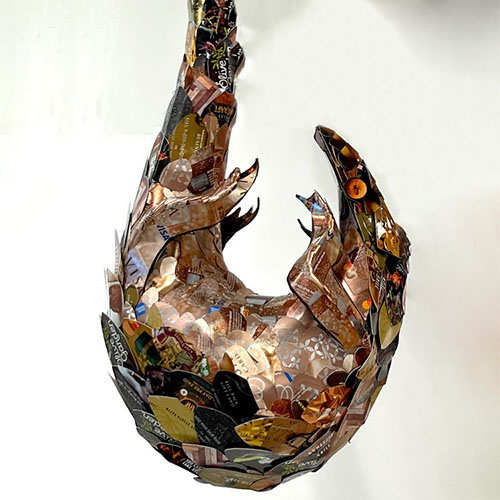
Streaming: Sculpture by Christy Rupp
Walsh Gallery
January 19 – April 27, 2024
Understood as one of the early pioneers in the field of ecological art activism, the artist, activist and thought-leader Christy Rupp has an international reputation. Streaming will feature a survey of Rupp’s intricate collages, wall installations and free-standing sculpture, which chronicle the ongoing tension between natural systems and the environment in transition, and call our attention to our interconnectedness with non-humans and habitat – transmuting detritus gathered from the waste stream through collage and sculpture to reveal what is hidden away from common view and understanding. Informed by science and the historical representation of natural history, the artwork in this exhibition examines the way we frame our opinions of nature, using irony and wit to represent the human impact on our natural habitat.
Image: Christy Rupp, Pangolin, 2022 steel, paper, and credit cards. Courtesy of the artist
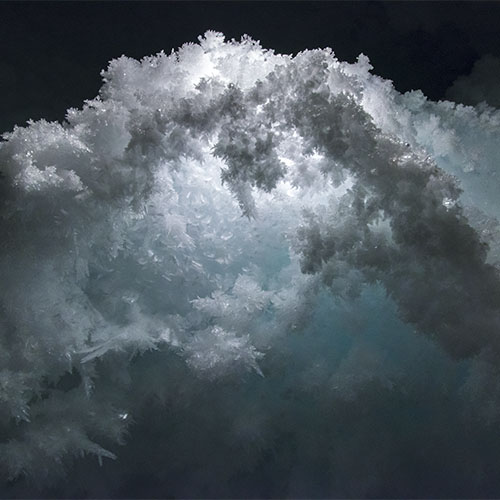
Helen Glazer: Walking in Antarctica
Bellarmine Hall Galleries
February 2 – March 16, 2024
This interdisciplinary exhibition includes photography and sculpture made from 3D scans of ice and rock formations, inspired and informed by the artist Helen Glazer’s experiences as a grantee of the National Science Foundation Antarctic Artists and Writers Program. It also includes an audio tour which takes the visitor on a series of “walks” through the Antarctic landscape, narrated by the artist.
Image: Helen Glazer, Fractal Arch, Erebus Ice Tongue Cave, Antarctica, 2015, archival pigment print. Courtesy of the artist
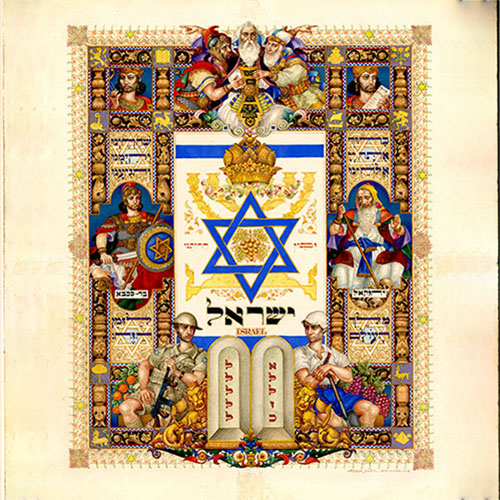
In Real Times - Arthur Szyk: Artist and Soldier for Human Rights
Bellarmine Hall Galleries (Main Exhibition) and Walsh Gallery (Szyk: The Interactive Experience).
September 29 – December 16, 2023
This special exhibition, organized around the theme of human rights features more than 50 works by acclaimed Polish Jewish miniaturist and political cartoonist Arthur Szyk (1894-1951), including political cartoons, and images that honor the power and importance of democratic ideals. A witness to the rise of totalitarianism in Europe, Szyk emigrated from London to America at the beginning of World War II. He lived and worked in Connecticut, and passed away in New Canaan in 1951. His powerful political cartoons animated the covers of magazines such as Time and Collier’s, raising awareness of the plight of European Jews and helping sway public opinion toward support for American participation in the Second World War. As a self-described “soldier in art,” Szyk’s work was acclaimed by First Lady Eleanor Roosevelt as a potent weapon “against Hitlerism.” He advocated for religious tolerance, racial equality, and human dignity. Active in the years leading up to World War II and during the Holocaust, Szyk became one of America’s most celebrated political artists for his powerful artistic and social contributions against Nazism and fascism. As our communities continue to confront issues of structural racism and social upheaval — including the sharp rise in antisemitic rhetoric and violence across the United States— this exhibition provides a platform for conversations on the urgent topics of human rights and social justice.
Organized by the University of California, Berkeley, The Magnes Collection of Jewish Art and Life, where it opened in May 2021, this exhibition is on view at the National World War II Museum in New Orleans through May 7, 2023, before coming to the Fairfield University Art Museum, which is its only stop in the Northeast. The exhibition will be on view in the Bellarmine Hall Galleries. In the Walsh Gallery, "Szyk: The Interactive Experience" invites visitors to explore and recombine motifs from Szyk's works into new images, which will be projected on the gallery walls. Additional films and other materials will be on view in this interactive display.
Image:Arthur Szyk, Israel (Heritage of the Nations series), 1948, watercolor and gouache, pen and ink and pencil on board. Courtesy of Taube Family Arthur Szyk Collection, The Magnes Collection of Jewish Art and Life, UC Berkeley.

In Their Element(s): Women Artists Across Media
Bellarmine Hall Galleries
April 21 – July 15, 2023
Curated by Fairfield University Phoebe Charpentier ‘23
The exhibition – the first exhibition in FUAM’s history to have been fully developed and curated by an undergraduate student – features more than 50 contemporary artworks by women artists.
Among the artists included in the exhibition are photographers Laurie Simmons and Donna Ferrato, painter and sculptor Linda Stein, and artist Ruby Sky Stiler. The majority of artworks in the exhibition will come from FUAM’s own collection, with select loans from the Westport Public Art Collections (WestPAC) and private collectors.
Image: Ethel Fisher, Room on East 89th Street, 1965, oil on linen. Gift of Margaret Fisher, 2022 (2022.09.02)
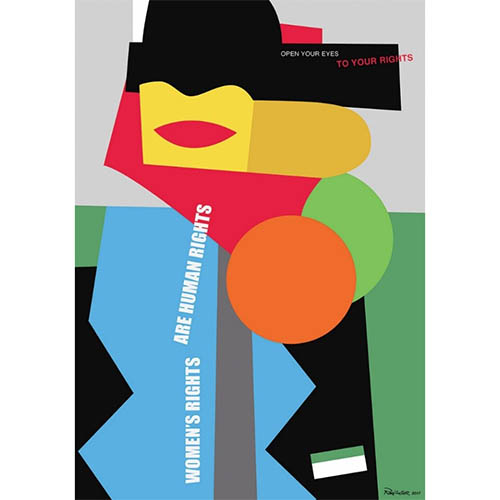
Women’s Rights are Human Rights
Walsh Gallery
January 20 – July 1, 2023 [*Extended*]
This exhibition features posters created by both men and women worldwide to celebrate and acknowledge the vital role that all citizens play in protecting and promoting human rights while challenging gender inequality and stereotypes, advancing reproductive and sexual rights, protecting women and girls against brutality, and promoting women’s empowerment, education, and participation in society. The posters argue for the empowerment of women, the achievement of equality between women and men, and the elimination of discrimination against women and girls.
Organized and curated by Elizabeth Resnick, Professor Emerita, Graphic Design, Massachusetts College of Art and Design, Boston. Co-curated by Fairfield University faculty Rachelle Brunn-Bevel, PhD, Liz Hohl, PhD, Johanna Garvey, PhD, and Anna Lawrence, PhD in collaboration with museum staff.
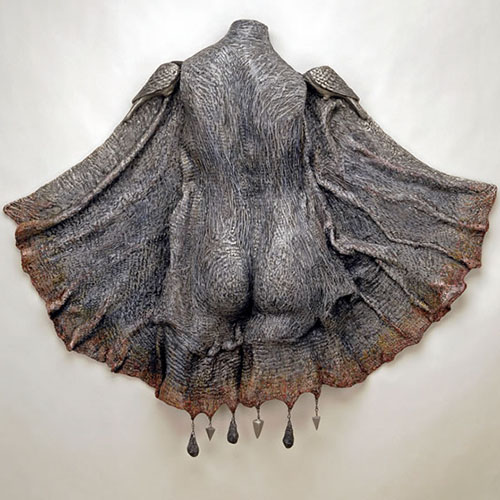
Norma Minkowitz: Body to Soul
Bellarmine Hall Galleries
January 27 – April 6, 2023
Norma Minkowitz: Body to Soul is a solo exhibition surveying the artist’s four-decade engagement with the physical and symbolic properties of thread. Minkowitz reinvents traditional needlework by crocheting fantastical forms, coating them in resin and shellac to create rigid sculptures and hangings. The delicate, mesh-like surfaces of her artworks break down oppositions between soft and hard, inside and outside, body and soul.
The poetic title Body to Soul is borrowed from just one of the sculptures that will be on view, but it is a broader theme that reverberates across the exhibition’s selection of over thirty vessels, sculptures, wall hangings, wearables, and works on paper – including never-before-seen examples coming from the artist’s studio.
Norma Minkowitz lives and works in Connecticut. Her work is represented in private and public collections across the United States and internationally. She is unique among fiber artists creating hard sculptures from soft materials, and for using thread to invoke universal themes of mortality, memory, nature, and writing. The exhibition is guest curated by Sarah Parrish PhD., Assistant Professor of Art History at Plymouth State University, New Hampshire.
Image: Norma Minkowitz, Baggage, 2007, fiber, paint, resin, courtesy of the artist
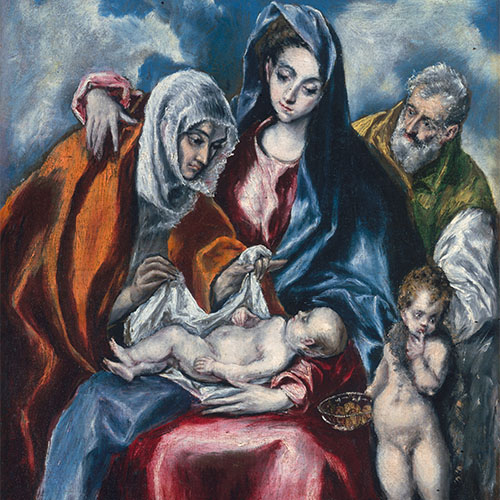
Out of the Kress Vaults: Women in Sacred Renaissance Painting
Bellarmine Hall Galleries
September 16 – December 17, 2022
The exhibition, curated by Michelle DiMarzo, PhD together with Fairfield University undergraduate students, explores representations of femininity and virtue in Renaissance paintings of the Virgin Mary, female saints, and nuns. Lenders include the National Gallery of Art, the Samuel H. Kress Foundation, the Harvard Art Museums, and the Lowe Art Museum, University of Miami, with an emphasis on Samuel H. Kress Collection works currently in storage at their home institutions.
Image: El Greco, The Holy Family with Saint Anne and the Infant John the Baptist, ca. 1595-1600, oil on canvas. National Gallery of Art, Washington, Samuel H. Kress Collection, 1959.9.4
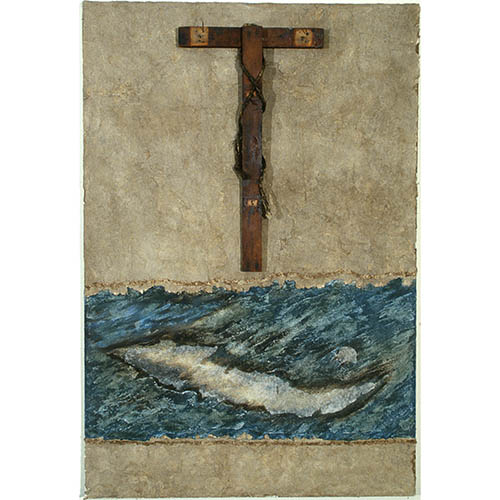
Gladys Triana: A Path to Enlightenment/Beyond Exile
Walsh Gallery
September 23 – December 17, 2022
Gladys Triana is a Cuban-born, New-York-based, multi-disciplinary artist whose work rebels against authoritarian rule, domination, and power. She explores themes related to the historical struggle of women and the condition of exile, as well as subjects such as ephemerality, memory, and ultimately the search for a language of transcendence. Triana’s body of work encompasses large-scale sculpture, immersive installations, photography, and mixed media, as well as painting and drawing. Curated by Aluna Curatorial Collective, this two-venue survey (at the Fairfield University Art Museum and the Art Museum at University of St. Joseph) spans work from the 1970s to the present. The work at Fairfield will focus on her early years in New York, and her sense of exile and feelings of isolation.
Image: Gladys Triana, Nothing is Sacred, 1995, acrylic and mixed media on plywood. Courtesy of the artist
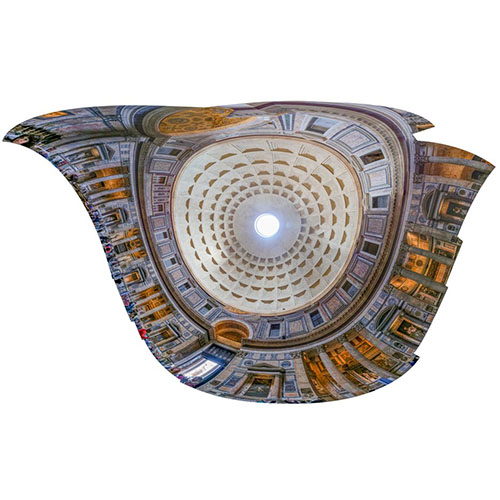
Specimens and Reflections
Bellarmine Hall Galleries
September 16 – December 17, 2022
Digitally manipulated photographic panoramas of the interiors of Roman churches by Claudia Esslinger (Professor of Art, Kenyon College) are accompanied by the poetry of Royal Rhodes ‘68 (Professor Emeritus of Religious Studies, Kenyon College) in this unique exhibition that explores the intersection of word and image.
Image: Claudia Esslinger, Santa Maria ad Martyres, Pantheon, photograph, courtesy of the artist

13 Ways of Looking at Landscape: Larry Silver's Connecticut Photographs
Walsh Gallery
March 25 – June 18, 2022
Larry Silver, a Photo League-inspired photographer still working today, moved from Greater New York to Westport, CT in 1973. With his camera, he began exploring his new regional environs, and pushing the boundaries of what landscape and looking is and can be. This exhibition, curated by Leslie K. Brown, PhD, will bring together over 40 years of Silver's work made of and in Connecticut.
Image: Larry Silver, Sitting at Water's Edge, Sherwood Island State Park, Westport, CT, 2014/2022,Courtesy of the artist and Bruce Silverstein Gallery, New York © Larry Silver
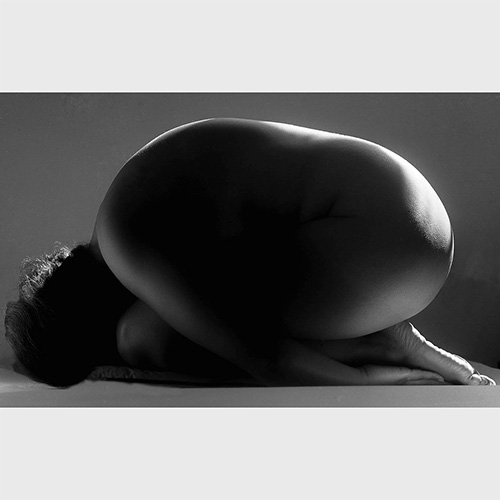
Adger Cowans: Sense and Sensibility
Bellarmine Hall Galleries
January 28 – June 18, 2022
Adger Cowans (American, b. 1936) is celebrated as one of the founding members of the Black photographers' group called Kamoinge. Curated by Halima Taha, PhD, this exhibition will explore how Cowans uses photography as a vehicle to articulate beauty within the human condition, and the world in which we live, and will feature over fifty works from across his illustrious career as a photographer of portraiture, landscape, and film.
Image: Adger Cowans, Egg Nude, 1958, silver gelatin print. Courtesy of the artist and Bruce Silverstein Gallery, New York. © Adger Cowans
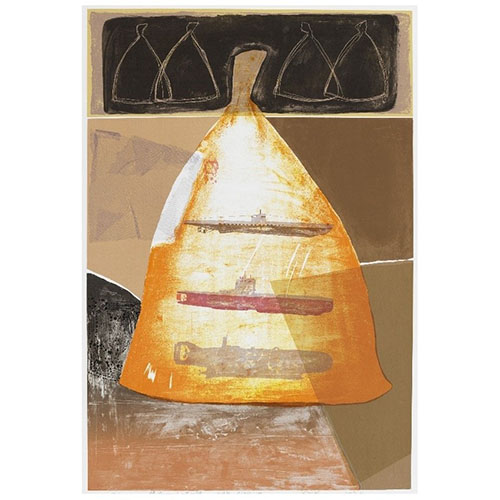
SEEING IS BELIEVING: Crossings and Transpositions, Part II
Walsh Gallery
January 21 - March 5, 2022
This exhibition, organized by Professor of Studio Art Jo Yarrington, features work by five contemporary Chinese artists: He Jiancheng, Xiao Yaoning, Luo Biwu, Zuo Zhengyao and Zhang Zhengmin. Yarrington travelled to China in 2016 with four other American artists, where they presented Part I of this international exchange.
Image: Luo Biwu, War in Bag, 2009, silkscreen print. Courtesy of the artist
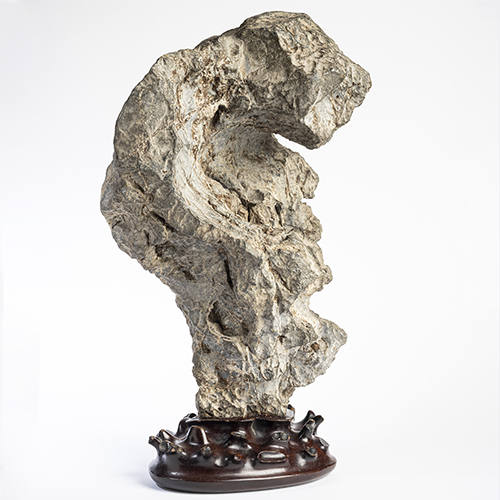
ink/stone
Walsh Gallery
January 21 – March 5, 2022
Curated by Ive Covaci, PhD, this exhibition will feature some 15 contemporary Chinese paintings and works on paper, presented together with stone sculpture, including a scholar’s rock. By showing late 20th and 21st century works inspired by traditional Chinese artistic subjects of rocks and mountains, ink/stone will investigate how contemporary artists deploy, evoke and transform this motif, using a range of media from ink on paper to oil on canvas.
Image: Scholar’s rock, ca. 18th century, stone, wood base. Lent by Jane and Leopold Swergold

Carrie Mae Weems: The Usual Suspects
Walsh Gallery
September 18 - December 18, 2021
In Carrie Mae Weems: The Usual Suspects, Weems focuses on the humanity denied in recent killings of black men, women, and children by police. She directs our attention to the constructed nature of racial identity—specifically, representations that associate black bodies with criminality. Our imaginings have real—often deadly—outcomes. Blocks of color obscure faces just as our assumptions around race obscure individual humanity. Through a formal language of blurred images, color blocks, stated facts, and meditative narration, Weems directs our attention toward the repeated pattern of judicial inaction—the repeated denials and the repeated lack of acknowledgement.
This exhibition is organized by LSU Museum of Art in collaboration with LSU College of Art + Design, and LSU School of Art. At the Fairfield University Art Museum, this exhibition is made possible by the generous support of the #UNLOAD Foundation. The Mary and Eliza Freeman Center for History and Community is a community partner for the museum’s programming this fall.
Image: Carrie Mae Weems, All the Boys (Profile 1), 2016, archival pigment print on gesso board. Courtesy of the artist and Jack Shainman Gallery
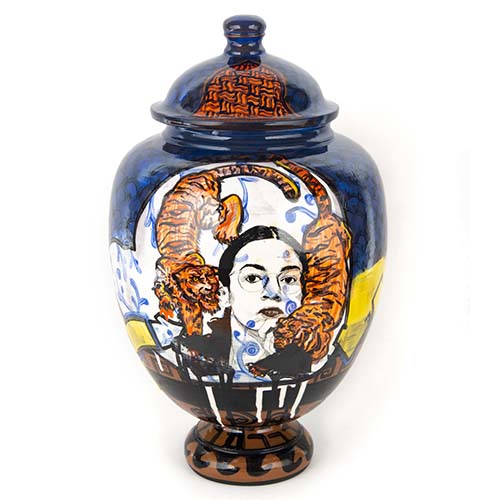
Roberto Lugo: New Ceramics
Bellarmine Hall Galleries
September 18 – December 18, 2021
Self-described "ghetto potter" Roberto Lugo uses porcelain, a medium traditionally reserved for the wealthy, to explore inequality and racial and social justice. His work often takes familiar shapes drawn from European and Asian ceramic traditions, including ginger jars, amphorae, and teapots, but their hand-painted surfaces take inspiration from street art and feature contemporary iconography, including celebrations of Black and Latino figures. A number of the pieces in this exhibition, which features all-new work, also incorporate gun parts from decommissioned handguns obtained in a Connecticut gun buyback sponsored by #UNLOAD Foundation.
This exhibition is made possible by the generous support of the #UNLOAD Foundation. The Mary and Eliza Freeman Center for History and Community is a community partner for the museum’s programming this fall.
Image:Roberto Lugo, Vengo dal Ghetto, AOC, 2020, cerámica vidriada. Fotografía de Dominic Episcopo por cortesía de la Wexler Gallery
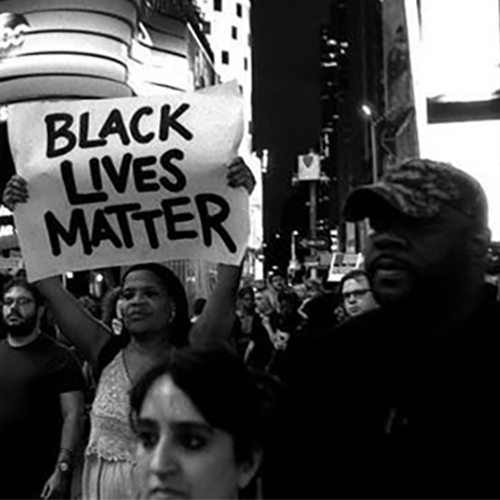
Robert Gerhardt: Mic Check
Fairfield University Art Museum | Bellarmine Hall Galleries
September 18 – December 18, 2021
Robert Gerhardt: Mic Check is a photography project by photojournalist and writer Robert Gerhardt, who relied on the #BlackLivesMatter hashtag to track and document these protests in New York City over the last seven years. This remarkable body of work includes photographs of protests from 2014 through 2021, across New York, in massive crowds, in rain and sun, during night and day, in motion during marches and stationary during speeches, and in the past year in the midst of a global pandemic. These candid works capture the passion, righteous anger, and frustration of the protestors. The title comes from the shouts of “mic check!” which mobilized protestors into a game of repeat-after-me, a technique that united the crowd and enabled the spread of the speaker’s comments and instructions without amplification.
Image: Robert Gerhardt, Protestors Marching through Times Square on the 5th Anniversary of the Death of Michael Brown, Times Square, New York City, August 9, 2019, silver gelatin print. Courtesy of the artist
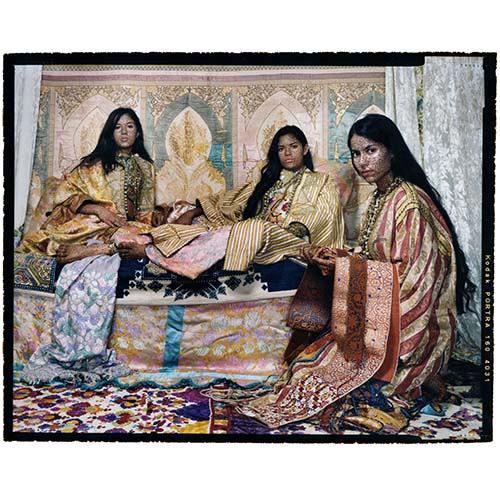
By Design: Theater and Fashion in the Photography of Lalla Essaydi
Walsh Gallery
January 29 - May 21, 2021
By Design: Theater and Fashion in the Photography of Lalla Essaydi explores the artistic process behind the creation of Essaydi’s carefully staged photographs, which deconstruct and reimagine stereotypes of Muslim womanhood. Guest Curator Cynthia Becker (Associate Professor in the History of Art & Architecture Department at Boston University) has selected approximately 20 works spanning Essaydi’s career for inclusion in this groundbreaking exhibition. Becker notes that, “This is the first time an exhibition has emphasized fashion and staging in Essaydi’s work ...[she] might spend months creating a single garment to be worn in one of her carefully crafted tableaus. She spends hours arranging her models and, in the process, recreates the familial bonds so important to Moroccan women’s lives.”
Born in Morocco, Lalla Essaydi lived in Saudi Arabia for many years and studied painting and photography at the École des Beaux-Arts in Paris and the School of the Museum of Fine Arts in Boston. She currently lives between New York and Morocco. Her time in Morocco also exposed her to the nation’s rich history of architectural design and the ceremonial occasions so important to daily life, both of which are featured in her photographs.
Image: Lalla Essaydi (Moroccan, b. 1956), Harem Revisited #31, 2012, chromogenic print. © Lalla Essaydi, Courtesy of the artist and Edwynn Houk Gallery, New York

Birds of the Northeast: Gulls to Great Auks
Bellarmine Hall Galleries
January 22 – May 14, 2021
Birds of the Northeast: Gulls to Great Auks features paintings, sculpture, prints, drawings, photographs, and natural history specimens from the early 19th century through the present day. Curated by Carey Weber and Fairfield University Biology professors, Brian Walker, Jim Biardi and Tod Osier, the show complements the installation on Fairfield’s campus of The Lost Bird Project by artist Todd McGrain. On view from October 2020 to June 2021, these five monumental sculptures were created as a public memorials to birds driven to extinction in modern times.
The Lost Birds section of the exhibition will include a Great Auk skeleton lent by the Peabody Museum of Natural History at Yale University along with preparatory drawings, photographs and maquettes for The Lost Bird Project by Todd McGrain. Complementing these works are paintings of lost birds by contemporary artists including Walton Ford, Ann Craven, James Prosek, Morgan Bulkeley, and Alberto Rey. The living birds section of the exhibition will include specimens of a variety of common, local birds, also coming from the Peabody. Highlights of this section of the exhibition include Marsden Hartley’s Give Us This Day, (lent by the Art Bridges Foundation), and Andrew Day Jackson’s portfolio There Will Come Soft Rains, which draws from numerous sources including old Audubon copper plates, to refer to both preservation and apocalyptic destruction (lent by the Jordan Schnitzer Family Foundation). Additional artworks depicting living birds include works by Alexander Wilson, John Gould, Emily Eveleth, James Prosek, Rick Shaefer, Carolyn Blackwood, Christy Rupp, Christina Empedocles, and Paul Villinski.
Image: Marsden Hartley (American, 1877 - 1943), Give Us This Day, 1938, oil on canvas. Lent by Art Bridges
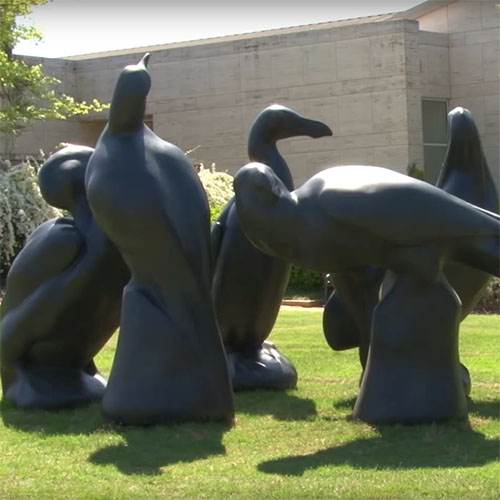
The Lost Bird Project
Fairfield University Campus
October 2020 – June 2021
Conceived by artist Todd McGrain The Lost Bird Project is part natural history, part artist's diary, documenting the extraordinary effort to place a series of public memorials to birds driven to extinction in modern times. The project is a chronicle of humankind's impact on our changing world and a moving record of dwindling biodiversity. The Fairfield University Art Museum will place these monumental bronze memorials to five “lost birds” (Carolina Parakeet, Great Auk, Labrador Duck, Passenger Pigeon, and Heath Hen), on the lawn in front of the DiMenna-Nyselius library.
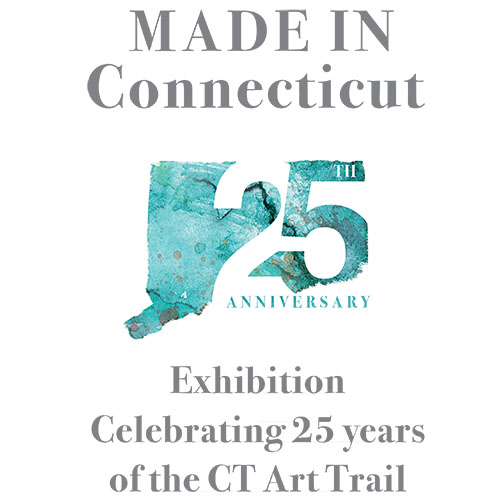
Made in Connecticut: Exhibition Celebrating 25 Years of the CT Art Trail
Wadsworth Atheneum Museum, Hartford, CT
Through February 7, 2021
One of the first tourism trails in the State — The Connecticut Art Trail — is celebrating 25 years of guiding art aficionados across the state on a journey that includes 22 world-class museums and historic sites. Originally launched in 1995 as the Connecticut Impressionist Art Trail, encompassing 10 museums, today the Trail includes more than double that number, plus a growing range of affiliate members including galleries and art-based environments. This exhibition which includes a number of works on loan from the Fairfield University Art Museum celebrates this important anniversary. View the virtual tour!

Ruby Sky Stiler - Group Relief
Walsh Gallery
September 11 – December 19, 2020
Featuring new relief paintings and figurative furniture-sculpture by New York artist Ruby Sky Stiler (b. 1979), this exhibition is presented as part of the celebration of 50 years of women at Fairfield University. Stiler, who holds a BFA from RISD and an MFA from the Yale University School of Art, has been investigating images of women inspired by the techniques and language of classical antiquity for over a decade. Recently, Stiler’s art has expanded to include the subject of “father and child.” The dearth of art historical precedent for depictions of men displaying emotional intimacy, or being defined by their relationship to their children, is in stark contrast to the abundant impressions of “mother and child.”
Curated by Ian Berry, Dayton Director of the Tang Teaching Museum, this exhibition will also include contemporary interpretations of the traditional museum “viewing bench” as a form of utilitarian sculpture. The exhibition will invite viewers to sit and consider their own bodies in relation to the gallery space and the ideas in the artwork on the walls. The exhibition will open with a virtual conversation between Ruby Sky Stiler and curator Ian Berry on September 10, 2020. The exhibition will travel and will be on view at the Tang Teaching Museum at Skidmore College in 2022.
Image: Ruby Sky Stiler, No Title (Warm Gemstones Bust), 2020, acrylic paint, acrylic resin, paper, glue, and graphite on panel. Courtesy of the artist and Nicelle Beauchene Gallery
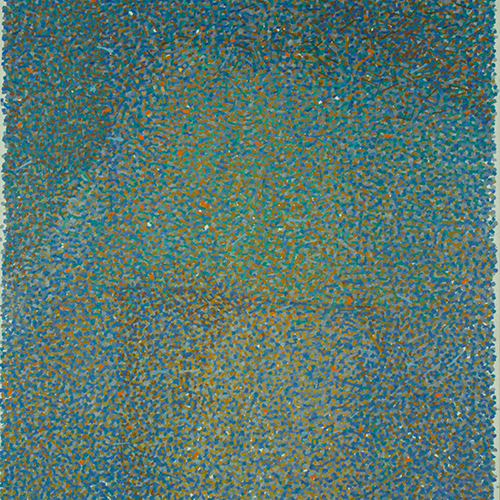
Andrew Forge: The Limits of Sight
Bellarmine Hall Galleries
September 25 – December 19, 2020
Organized by scholar and guest curator Karen Wilkin, this exhibition will feature some 20 paintings and works on paper by British artist Andrew Forge (British, 1923-2002). Forge was a painter and art critic, as well as the dean and professor of the Yale University School of Art from 1975-1994. His highly personal abstractions distill his perceptions of place, season, and time of day into subtle orchestrations of pure color. Through this rich presentation, museum visitors – students and faculty as well as the many members of the general public who attend our exhibitions and programs each year – will be introduced to the work of this important contemporary artist. Lenders to the exhibition include numerous private collections, the artist’s widow Ruth Miller, and the collections of the Yale University Art Gallery and the Yale Center for British Art.
Image: Andrew Forge, Cloak, 1985, oil on canvas. Collection of Patrick J. Waide Jr. ‘59
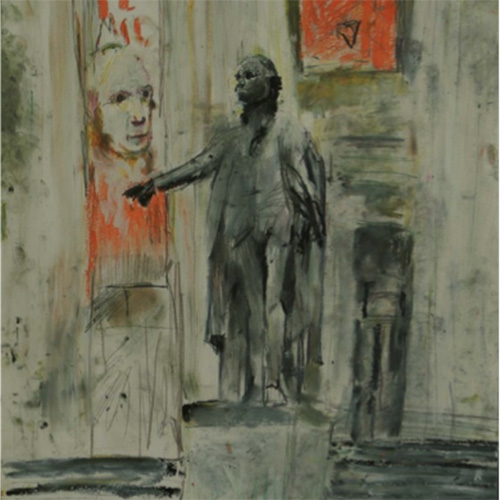
Howard Skrill: Monumental Follies
Online
Virtual exhibition opening on June 4, 2020.
Featuring over thirty works by New York artist Howard Skrill (b. 1962), this exhibition explores the impact of public monuments, as well as their removal, and their absence. Howard Skrill is an artist and art professor at St. Francis College, Brooklyn, NY and Essex College in Newark, NJ. He has exhibited extensively throughout New England, and his pictorial essays and other works have appeared in publications worldwide. In his drawings and paintings, Skrill documents figurative public statuary, surveys their destruction or relocation, and explores the fractured nature of personal and public memory, as well as the contemporary reaction to these historical works. Many of Skrill’s works were painted en plein air, or in the open air, recording not just the monuments, but the constant changes of light and color encountered out of doors.
On October 8 Dr. Harriet Senie will give a talk entitled: Memorials Today: New Subjects, New Forms, and the Public Process. In this conversation, Dr. Senie will unpack the complex and often opaque bureaucratic processes underlying how the decisions that shape the memorials occupying real estate in our prime public spaces are made.
Harriet F. Senie is Director of the M.A. Program in Art History and Art Museum Studies at City College, CUNY, and teaches at the CUNY Graduate Center. She is the author of several books and numerous articles on public art, and is co-founder of the international organization Public Art Dialogue and co-editor of its journal, Public Art Dialogue. She was a member of the Mayor’s Advisory Commission on City Art, Monuments, and Markers, and the She Build New York Advisory Committee.
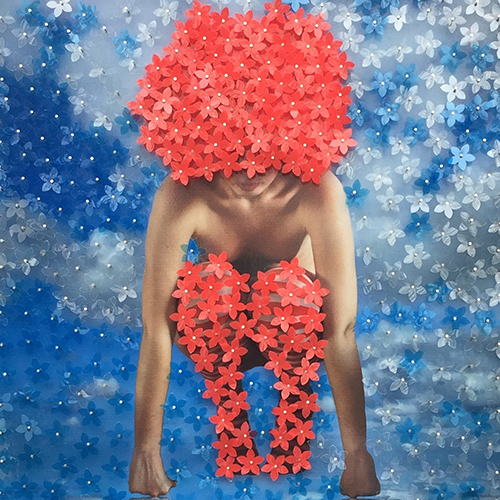
Archives of Consciousness: Six Cuban Artists
Walsh Gallery, Quick Center for the Arts
January 24 – May 15, 2020
Featuring recent and key past works by internationally renowned artists, this exhibit explores the many mythologies of liberation and fulfillment promised by modern life as well as the peculiar challenges they represent for island Cubans who must navigate Cuba’s contradictory system of combining capitalism with Communist rule since the fall of the Soviet Union in 1991. Through sculpture, painting, photography and mixed media, artists Roberto Diago, Manuel Mendive, Eduardo (“Choco”) Roca, Abel Barroso, Mabel Poblet and Luis Camejo interrogate the ways that consumerism, migration, patriarchy and the legacies of slavery shape the definitions and differential experiences of freedom that twenty-first-century technology affords all of us. Yet these works anchor the viewer in deeply Cuban locations of consciousness, revealing how austerity and sacrifice, self-reliance and dependence, fear and valor, joy and anguish reflect central principles of survival in a society where egalitarian dreams have long clashed with scarcity, poverty and painful political realities.
In Mendive’s mixed media sculptures and vivid paintings that evoke the spiritual world of Regla de Ocha (the slave-born religion better known as Santería) as well as Mabel Poblet’s deceptively iconic images of feminine beauty in objects made from recrafted photographs, Archives of Consciousness draws on culturally specific worlds of feeling to create visually stunning dialogues of wisdom and understanding. While Luis Camejo’s vast canvases depict Havana’s urban landscapes, punctuated with cars, shoppers and pedestrians, Abel Barroso painstakingly documents the daily struggles of Cubans to claim the right to both knowledge and leisure in whimsical, hand-carved wooden sculptures and intricate collages of hundreds of pencil shavings. Diago’s highly moving spiritual and abstract works made up of geometric pieces of canvas deeply woven together and texturally raw paintings on wooden planks draw on the complexities of his Afro-Cuban heritage and its struggle to survive despite efforts to eradicate it. Master printmaker Choco summons intensity in colorful sculptures and collographs that document how political scrutiny and an exclusionary gaze haunt and historically define the limits of identity and personal freedom for all Cubans, but most especially for those of African descent.
Drawn from the collection of Terry and Steven Certilman, the works of these six artists open up a living archive of thoughts and aspirations, enabling us to reflect on the essences and emotions that make up the paradoxes of life and the strength that comes from their exploration.
Lillian Guerra
Curator
Image: Mabel Poblet Pujol, Reflected(Reflejada), 2015, Digital image, PVC, metal, acetate.
Image courtesy of the artist. ©Mabel Poblet Pujol
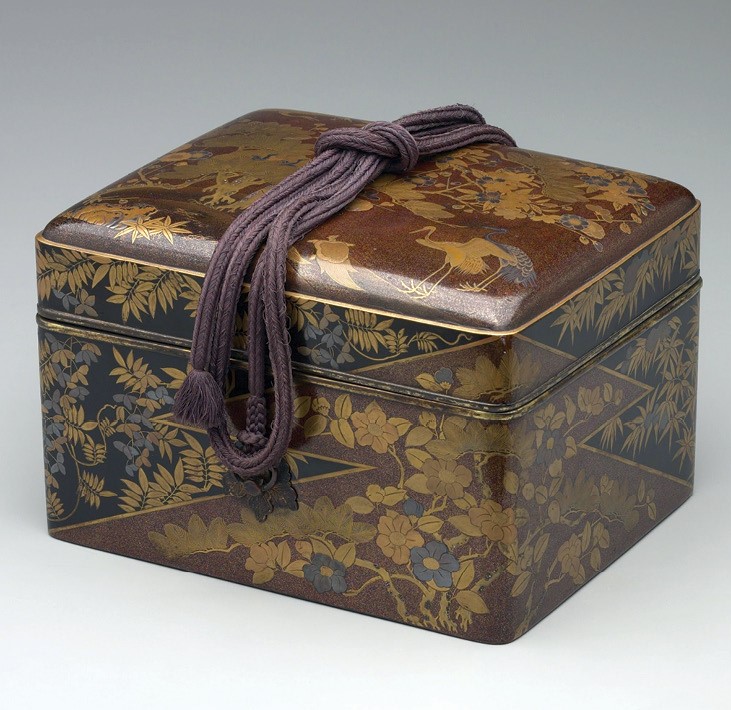
Gifts of Gold: The Art of Japanese Lacquer Boxes
Bellarmine Hall Galleries
January 17 – May 15, 2020
Gifts of Gold: The Art of Japanese Lacquer Boxes will introduce viewers to the medium, functions, decorative techniques, and symbolic associations of Japanese lacquer by presenting approximately twenty exquisite works ranging from the 15th through the 21st centuries, complemented by a few select paintings. The exhibition will consist of four groupings with the following themes: 1) forms in black and red 2) seasonal and auspicious motifs 3) poetic and literary associations 4) materials and techniques. Objects in the exhibition are drawn from institutional and private collections, as well as featuring a 19th century writing box recently acquired by the Fairfield University Art Museum.
In Japan, true lacquerware is created through a time-consuming process wherein the sap of the lacquer tree is harvested, refined, and pigmented before being applied in successive layers to a substrate, often of wood. Each layer of lacquer cures and hardens, rendering the vessel waterproof and durable. Although many wares are left plain to showcase the glossy black or red finish, the art reached heights of decorative potential with developments in the 16th and 17th centuries in techniques of “sprinkled picture” (maki-e) decoration. In these uniquely Japanese techniques, small particles of gold and other metals are sprinkled onto lacquer in abstract and pictorial designs, rich with seasonal, poetic, and literary allusions. Although lacquer objects were ultimately functional – writing boxes, storage boxes, tea caddies, tables, and dining utensils – the expense and decorative richness ensured that some objects were rarely used. Lacquer boxes therefore also became markers of status, taste, and wealth. Tebako, or cosmetics boxes, were important elements of a bride’s trousseau, and writing boxes (suzuribako) stored the implements used for calligraphy; such boxes could also be presented as gifts on important and auspicious occasions, such as the New Year. Moreover, small seal and medicine cases (inrō) with exquisite designs were worn suspended from the belts of men’s traditional dress and displayed the height of fashion in the Edo period (1615-1868). Borrowing from – and in turn influencing – other arts in Japan, the lacquer tradition stands in conversation with arts such as textile design, ceramics, painting, calligraphy, and sculpture.
The exhibition is curated by Ive Covaci, PhD, adjunct professor of art history in the Visual and Performing Arts Department, and will be accompanied by a full program of lectures, gallery talks, and demonstrations. Listen to the audio guide.
Image: Trousseau Box, Edo period (1615-1868), mid-to late 17th century, black lacquer ground on wood with decoration in gold. On loan from Yale University Art Gallery (gift of Peggy and Richard M. Danziger, LLB. 1963, 2001.801)
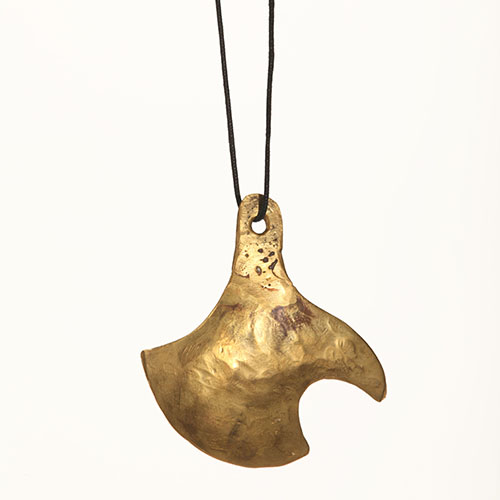
Sculptured Adornment: The Jewelry of David Hayes
Bellarmine Hall Galleries
October 4 - December 21, 2019
Humans have been crafting and wearing jewelry for the past 5,000 years. More than simple accessories, these objects serve as symbols of class, family, gender, and originality. Jewelry can also be seen as miniature sculptures worn on the body; in this light, jewelry celebrates the union of craft and materials, as artists have built upon both old and new techniques to create work that enriches the experience of both wearer and viewer. The exhibition Sculptured Adornment: The Jewelry of David Hayes focuses on the work of a sculptor who branched into jewelry-making during the 1950s. The pieces of jewelry on view primarily served as gifts for Hayes’ family members and friends, and represent the loving relationships he had with them. This exhibition, which opened at the Georgia Museum of Art in May 2019, presents these personal ornaments to the public for the first time. Hayes was born in 1931 and grew up in Connecticut during the Depression and the Second World War. He left New England for college in the Midwest, earning a bachelor’s degree in art from Notre Dame in 1953 and a master’s in 1955 from Indiana University. Hayes won a Fulbright scholarship and subsequently spent eight years in France. Along the way, he met several artists who influenced his skills and aesthetics, including the abstract sculptors David Smith and Alexander Calder. Hayes died in Coventry, CT in 2013. Hayes’ sculptures combined seemingly organic shapes with industrial materials, often on a monumental scale. His jewelry, in contrast, is small and delicate. This intimate exhibition includes approximately 40 brooches and pendants. Most of the brooches do not have clasps, leaving flexibility for the wearer to determine how to attach them to clothing. The hammered surfaces of these talisman-like objects brings the strength and mystery of iron-shaping into the 20th century. Both naturalistic and abstracted elements in the pieces on view suggest an otherworldly aesthetic.
Image: David Hayes, Pendant n. 31, n.d. Brass. Collections of the artist
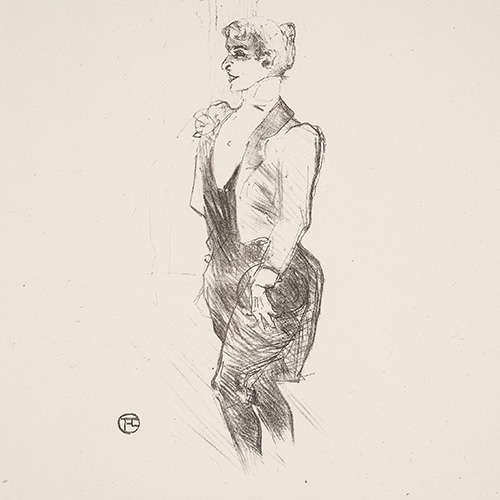
Prints from the Age of Rodin
Bellarmine Hall Galleries
October 4 - December 21, 2019
Presented in conjunction with RODIN: TRUTH, FORM, LIFE / Selections from the Iris and B. Gerald Cantor Collections (Walsh Gallery, September 13 – December 21, 2019), Prints from the Age of Rodin features lithographs and etchings by Rodin’s contemporaries, ranging from views of the urban environment of Paris, to portraits of artists, writers, and thinkers, to theater playbills and advertisements.
Drawn from the museum’s permanent collection, as well as selected items on loan from the Jundt Art Museum of Gonzaga University, the exhibition includes works by Berthe Morisot, Henri Toulouse-Lautrec, and Félix Vallotton that illuminate the rich cultural atmosphere of Paris during the late 19th and early 20th centuries. Listen to the audio guide.
Image: Henri de Toulouse-Lautrec, Mary Hamilton, 1894. Lithograph. Promised gift of James Reed
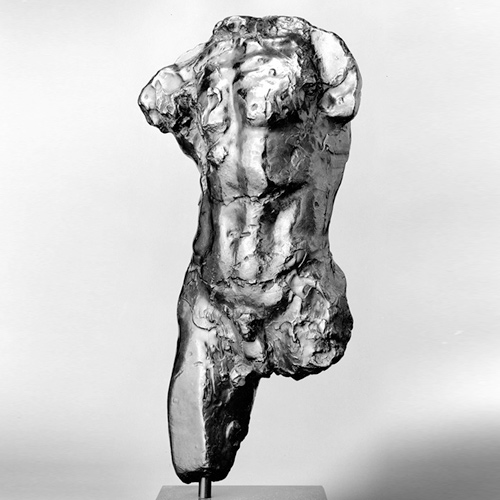
RODIN: TRUTH, FORM, LIFE Selections from the Iris and B. Gerald Cantor Collections
Thomas J. Walsh Gallery
September 13 - December 21, 2019
This small but powerful retrospective called RODIN: TRUTH, FORM, LIFE, Selections from the Iris and B. Gerald Cantor Collections is comprised of 22 bronzes.
Visitors to this exhibition will come face to face with the powerful emotions embedded in the works of the “father” of modern sculpture.
Rodin’s focus on depicting human emotion and intimate moments upended the world of traditional sculpture in the late 19th and early 20th centuries. His innovative processes of repetition and multiplication broke boundaries, and his influence endures today.
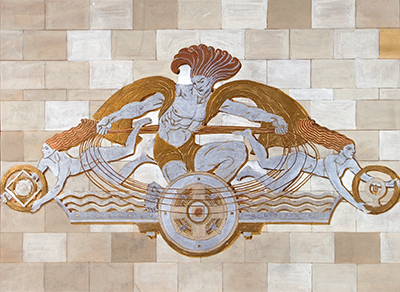
Hildreth Meière: The Art of Commerce
Bellarmine Hall Galleries
April 18 – September 21, 2019
Hildreth Meière was a prolific muralist whose commissioned works adorn the walls and ceilings of public buildings from New York to California. Born in New York in 1892, Meière first studied art in Florence, Italy, where she discovered the frescoes and mosaics that were to inform her craft. Continuing her studies in New York, California, and Chicago, she traveled to Europe during the summers where she was introduced to les arts decoratifs, later to be known as Art Deco, of which she became an early exponent.
Some of Meière’s best known works are in New York City and include the Dance, Drama, and Song roundels that grace the limestone façade of Radio City Music Hall, the arch and ark mosaics in the Temple Emanu-El, and the red and orange glass mosaics in the Banking Room at One Wall Street. A versatile artist whose commissions were executed in glass and marble mosaic, tile, terra cotta, tapestry, leather, wood and metal, Meière understood that her success was in large part due to the positive collaboration she forged with corporate clients, architects, and the talented craftsmen who executed her works.
Hildreth Meière: The Art of Commerce highlights corporate commissions in New York, New Jersey, and Connecticut and includes paintings, wall sculptures, preparatory drawings, cartoons and gouache sketches, as well as photographs of finished commissions. Also included in this exhibition are the full-size cartoons for the mosaic in the lobby of the Travelers Insurance Company in Hartford, CT.
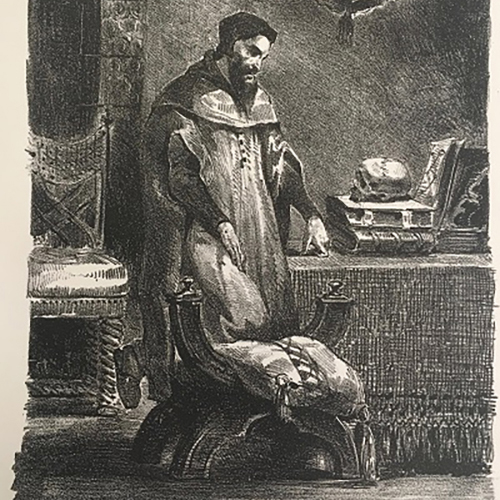
The Artist Collects: Highlights from the James Reed Collection
Thomas J. Walsh Gallery
March 14 – June 8, 2019
This exhibition celebrates the transformative gift of the James Reed Collection of Old Master, 19th-century, and modern prints to the Fairfield University Art Museum. Assembled over several decades by artist, collector and Master Printer James Reed, the collection comprises more than 1,500 prints spanning the 16th through the early 21st centuries. The exhibition presents highlights from the three great strengths of the Reed Collection: 19th-century French etching and lithography; German Expressionist woodcuts and lithographs; and modern and contemporary prints.

A French Affair: Drawings and Paintings from The Horvitz Collection
Bellarmine Hall Galleries
January 25 – March 30, 2019
History, mythology, poetry, and portraiture provided a vast range of subject matter for French artists of the 17th, 18th and early 19th centuries. Drawn from the peerless holdings of The Horvitz Collection—one of the world’s most comprehensive collections of early modern French art—this exhibition features paintings and drawings in all these genres by such celebrated artists as Charles Le Brun, Nicolas de Largillière, Jean-Honoré Fragonard, Jean-Baptiste Oudry and Anne-Louis Girodet de Roucy Trioson. The impressive selection of over 50 drawings, some exhibited with related prints, focuses on a particular category—designs for book illustration—thereby highlighting not only the creative inventiveness of the artists who formulated lavish visual imagery from the written word, but also the rich literary traditions of France and the vibrant book publishing industry they spawned.
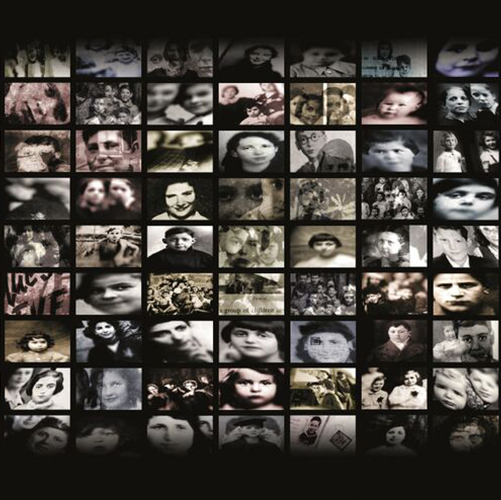
Ghosts: French Holocaust Children
Thomas J. Walsh Gallery
January 24 – March 2, 2019
During World War II, over 11,000 Jewish children were deported from France to Nazi death camps. These children were among more than 75,000 French Jews deported under the Nazi plan for the “Final Solution to the Jewish question.” Of those French Jews transported, only 2,564 survived the Shoah. At most 300 of these Jewish children survived.
Ghosts: French Holocaust Children is an installation of sculptural and photographic work by Robert Hirsch and Hirsch Projects. This three-dimensional installation acts as an ethereal commemoration to these children’s abbreviated lives. The project was created based on documents and photographs collected by author, lawyer, and Nazi-hunter Serge Klarsfeld that have been reinterpreted and presented in the form of three 1/5-scale boxcars containing over 600 expressionistic portraits of these deported children, plus a series of mural-sized individual portraits.
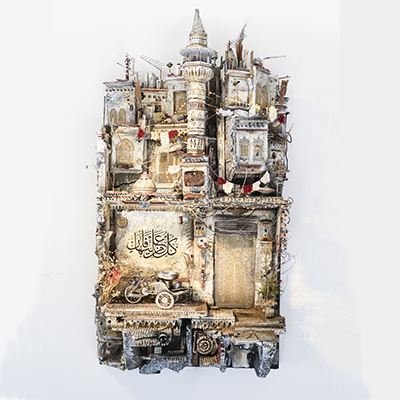
Mohamad Hafez: Collateral Damage
Thomas J. Walsh Gallery
October 26 – December 15, 2018
Born in Damascus, raised in Saudi Arabia, and educated in the Midwestern U.S., artist and architect Mohamad Hafez explores the impact of the political turmoil of the Middle East through hyper-realistic streetscapes crafted from found objects, paint, and scrap metal. Architectural in appearance yet politically charged in content, his miniaturized tableaus are alternately nostalgic, charming, and deeply painful.
Mohamad Hafez: Collateral Damage features a selection of work across multiple projects, including the site-specific installation Sea Garbage, as well as pieces from his Baggage series, in which the artist creates tableaus suggestive of the experience of refugees – many of whom are forced to flee their homes at short notice, or with only as much as they can carry – and places them inside vintage suitcases.
This exhibition also features selected works by two contemporary Syrian artists, photographer and digital artist Hala el-Abed and filmmaker Waref abu Quba, which explore themes of violence and loss centered around the Syrian refugee crisis.
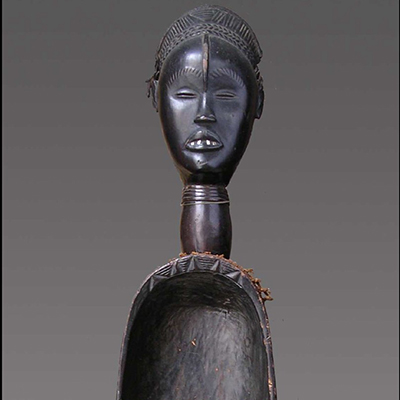
Liberia, 1931-33: The Collections of Alfred J. Tulk
Bellarmine Hall Galleries
September 14 - December 14, 2018
Many important collections of West African art trace their origins to the state of Connecticut. This exhibition highlights objects acquired in the early 1930s by Connecticut artist Alfred James Tulk of Stamford.
Born in London in 1899, Alfred Tulk studied art at Oberlin Art College and then Yale University, from where he earned his BA in 1923. Tulk is best known for his public mural paintings, stained glass windows, and mosaics, many of which he completed during his tenure at the Rambusch Decorating Company in New York City. Between 1925 and 1954, he painted over 300 large murals for theatres, churches, hotels, restaurants, and private homes in the United States.
In 1931, Alfred Tulk and his wife, Ethel Tulk, traveled from their home in Connecticut to rural Liberia, where they spent one year living and working in Ganta at the American Methodist mission station established there in 1926 by Tulk's close friend, medical missionary Dr. George W. Harley. While in Liberia, Tulk assembled a small but important collection of masks, statues, and other objects of daily use and material culture a number of which have been re-assembled for this exhibition. He also created a portfolio of portrait drawings and oil paintings which he created in situ of local subjects from the region around Ganta. The exhibition will include several of Tulk's own artworks, as well as some of his field photographs, his map of Liberia, selected correspondence, and a copy of his original handwritten field diary.
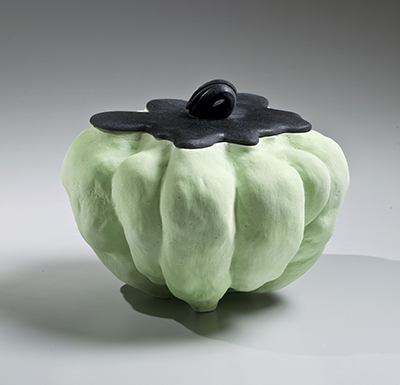
Mizusashi: Japanese Water Jars from the Carol and Jeffrey Horvitz Collection
Bellarmine Hall Galleries
June 5, 2018 - December 14, 2018
A mizusashi is a utensil used in the Japanese tea ceremony, a tradition with medieval origins that is still widely practiced today. In a tea gathering, a host prepares bowls of tea by whisking together powdered green tea and hot water drawn from a kettle. The mizusashi, typically an earthenware or stoneware jar, holds the water used to replenish the kettle and rinse the bowls. The first utensil to enter the room and the last to leave, the mizusashi is a locational and aesthetic anchor for the gathering and can take a wide variety of shapes, sizes, and appearances. This selection of 20th- and 21st-century mizusashi highlights two important trends-the perpetuation of longstanding tea traditions alongside the artistry and technical excellence that define modern Japanese ceramics.
Image © Katsumata Chieko
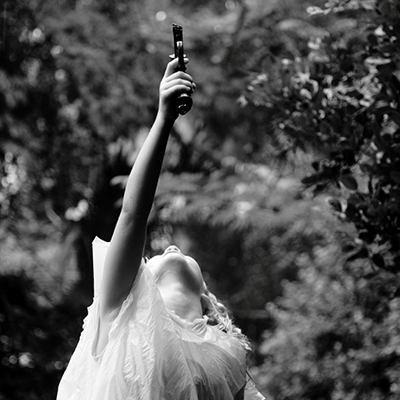
UNLOAD: Guns in the Hands of Artists
Thomas J. Walsh Gallery
June 1 - October 13, 2018
The Fairfield University Art Museum, in partnership with # UNLOAD and the Guns In The Hands of Artists Foundation, is proud to announce the opening of the exhibition, # UNLOAD : Guns in the Hands of Artists. Each piece in the exhibition was created using decommissioned guns, taken off the streets of New Orleans via a gun buyback program and distributed to internationally-known artists. Painters, glass artists, sculptors, photographers, poets, and other artists used the decommissioned firearms to create works of art that address the complex issue of guns and gun violence. The exhibition originated in mid-1990s New Orleans, where a spiking murder rate led artist Brian Borrello to conceive of the first iteration of Guns in the Hands of Artists exhibition by bringing the discussion over the role of guns and gun violence in our society into the realm of art -- art as the language for dialogue and possibly change without the often partisan and polarized politics that surround the issue. Borrello and gallery owner Jonathan Ferrara mounted this exhibition at Positive Space The Gallery in September 1996 in the Lower Garden District of New Orleans. In 2014, Ferrara reorganized the exhibition to feature work by internationally recognized artists. Through their own medium, each artist has used the decommissioned firearms to create works that express a thought, make a statement, open a discussion, and stimulate thinking about guns in our culture.

William Kentridge: Universal Archive
Thomas J. Walsh Gallery
March 1 – May 19, 2018
The exhibition presents new works on paper by renowned South African artist William Kentridge (b. 1955), inspired during the writing of his Norton Lectures, which he delivered at Harvard University in 2012. In more than 75 linocut prints based on ink sketches and printed on dictionary and encyclopedia pages, Kentridge revisits a familiar personal iconography, including coffee pots, typewriters, cats, trees, nudes and other imagery, exploring a thematic repertoire that has appeared in art and stage productions throughout his long career. The prints, which shift from identifiable subject matter to deconstructed images of abstract marks, form juxtapositions with the underlying text that suggest skepticism about the creative process and knowledge construction.
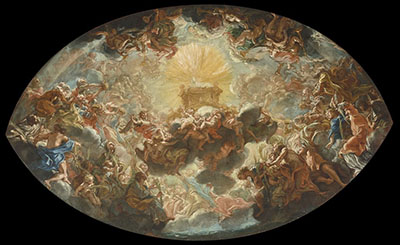
THE HOLY NAME: Art of the Gesù: Bernini and his Age
Bellarmine Hall Galleries
February 2 – May 19, 2018
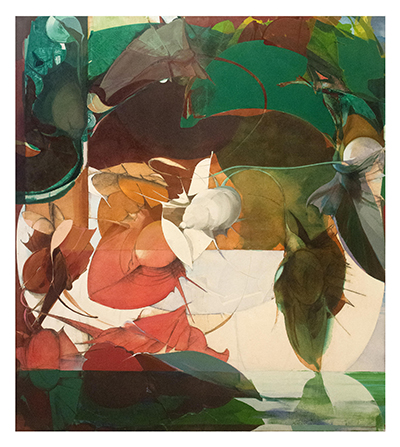
Richard Lytle: A Retrospective
Thomas J. Walsh Gallery
September 15, 2017 – February 3, 2018
Richard Lytle (American, b. 1935) has been exhibiting his work internationally since the mid-1950s. He attended the Cooper Union, then graduated from Yale University with a BFA in 1957 and from Yale College of Art with an MFA in 1960. While still in graduate school, he was selected for Dorothy Miller’s seminal 1959 “Sixteen Americans” at the Museum of Modern Art in New York. He was in auspicious company, as this exhibition introduced the museum-going world to Jasper Johns, Frank Stella, Robert Rauschenberg, Louise Nevelson and Ellsworth Kelly among others.
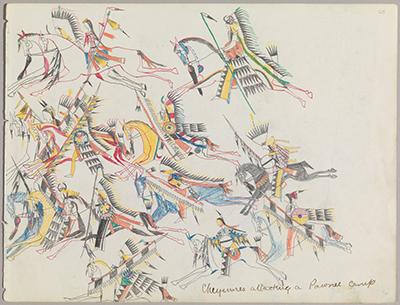
Picturing History: Ledger Drawings of the Plains Indians
Bellarmine Hall Galleries
September 27 - December 20, 2017
In the second half of the nineteenth century, artists from the Plains Indian peoples (Lakota, Cheyenne, Arapaho and others dwelling in the Western United States and Canada) produced an extraordinarily rich and distinctive body of drawings chronicling battles, rituals, and winsome if sometimes jarring events of everyday life. Known as Ledger Drawings because they were done on the pages of commercially produced account books, these striking images, many bearing pictographic signatures, are executed in ink, graphite, and colored pencil and watercolor. Some favor flat, stylized forms and a stark economy of means, while others show a lyrical predilection for rhythmic movement, minute descriptive and narrative detail, and dense, mosaic-like surface patterns. What all share is their makers' acute powers of observation and ambition to record and describe recognizable people, places, things and events-to eloquently picture and record history as it transpired.

Michael Gallagher Sketching the Landscape: A Plein Air Journal
Bellarmine Hall Galleries
April 21 - September 8, 2017
In his professional life as one of the world's foremost paintings conservators, Michael Gallagher has worked on masterpieces by such luminaries of European art as Botticelli, Michelangelo, Poussin, Rubens and Velázquez. Calling on specialized knowledge of materials and techniques used by painters at different moments in history, his sensitive interventions have helped recover the artists' intentions, revealing luminous surfaces and lost details of panel paintings and canvases that had been compromised by damage and obscured by later overpaint and darkened varnish.
In his private moments Gallagher has long sketched and painted landscapes--poetic, evocative and light-dappled scenes of rolling hills, sparkling seasides, rocky outcroppings and moody forests. Done in vastly diverging locales in different continents and hemispheres, at different times of day, and in all four seasons, his plein air watercolors and oil sketches capture a nuanced sense of place, at once changing and immutable, undisturbed by human presence. Discretely observed and inflected by a reticent silence, these ruminations on the landscape in its myriad manifestations form a journal of visual responses, chronicled over time.
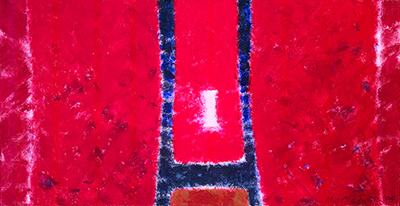
H. A. Sigg: Abstract Rivers
Thomas J. Walsh Gallery
March 24 - June 10, 2017
H. A. Sigg was born in Switzerland in 1924 and studied in Zurich and later Paris, where he was especially captivated by the art of French Nabi painter Pierre Bonnard. Although his paintings of the 1950s adhere to a figurative idiom, he evolved a purely abstract style, whose graceful, atmospheric and minimalist forms and motifs were inflected by aerial views of Southeast Asia, a vantage point he was afforded in 1968 when he was invited by Swissair to fly as "artist in residence in the sky."; From his privileged, sweeping view from the cockpit, he made sketches of the distant topography below. These became the inspiration and the source of the lithe and geometric abstractions suggestive of terraced fields and gently meandering rivers that characterize his work beginning in the 1970s.
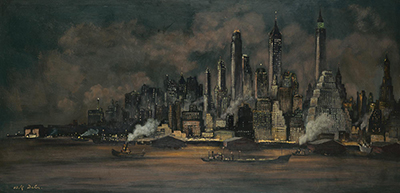
Adolf Dehn: Midcentury Manhattan
Bellarmine Hall Galleries
January 27 - April 7, 2017
This exhibition will explore the Manhattan subjects of National Academician Adolf Dehn (1895-1968). Visiting, and then living in New York City, Dehn captured the essence of the city in his paintings, prints and drawings of the landscapes of Central Park, and of the city's burlesque and night club scenes. While best known as a lithographer and one of the founding members of the American Artists Group, Dehn played a significant role in America's contemporary realist movement starting in the 1930s. He was included in every Whitney Museum of American Art "Annual" and "Biennial" invitational exhibition from the first biennial 1932 into the early 1960's, and still holds the record for being in more of these prestigious shows than any other artist. His work is in the permanent collections of more than eighty museums.
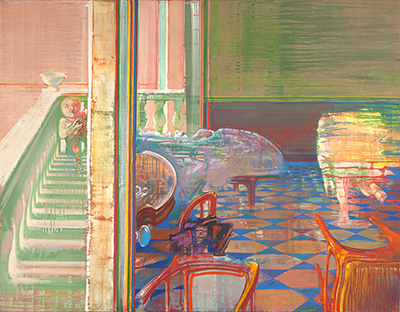
Leonardo Cremonini (1925-2010) Timeless Monumentality: Paintings from The William Louis-Dreyfus Foundation
Thomas J. Walsh Gallery
November 4, 2016 - March 4, 2017
Leonardo Cremonini was one of the preeminent Italian painters of the twentieth century. Widely admired, critically acclaimed, and technically accomplished, his works are to be found in the Museum of Modern Art in New York, the Hirschhorn Museum in Washington, D. C., the Musée d'Art Moderne, Centre Georges Pompidou in Paris, and numerous other public collections across Europe and the United States.
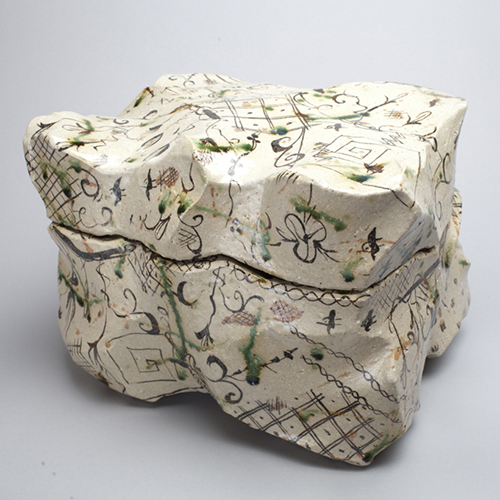
Crafting the Elements: Ceramic Art of Modern Japan from the Collection of Carol and Jeffrey Horvitz
Bellarmine Hall Galleries
September 29 - December 16, 2016
Ceramic art is an ancient, enduring and vibrant form of creative expression in Japanese culture-a medium created from the fusion of the elements earth, fire, and water. Contemporary ceramic artists in Japan are deeply mindful of the venerable forms and traditions underlying their craft, and their works frequently abound with historical references. At the same time, many of these artists boldly bend and stretch artistic conventions to incorporate new forms and ornamental language. Echoes of ceremonial vessels and implements co-exist beside fluid, organic and evocative shapes that push the medium to its most elastic possibilities.

Don Gummer: The Armature of Emotion: Drawings and Sculpture
Thomas J. Walsh Gallery
March 3 - June 11, 2016
This exhibition presents drawings and sculptures by internationally renowned artist Don Gummer. Gummer's richly layered, cerebrally composed drawings incorporate color, encaustic (an ancient technique in which pigment is suspended in wax) and collage. Reiterating many of the forms and motifs articulated in his reliefs and his free-standing sculptures, they function both as fluid heralds and intermediaries, and as autonomous creations. Informing Gummer's drawings and sculpture alike is an innate and immutable sensibility for structure. In the disciplined architecture that undergirds the construction of forms, Gummer achieves a paradoxical synthesis of stasis and flow--an elastic armature capable at once of containing and expressing emotion.
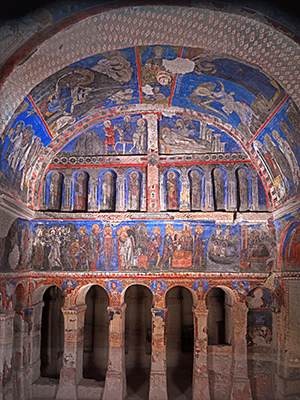
Vaults of Heaven: Visions of Byzantium
Bellarmine Hall Galleries
April 15 - September 16, 2016
The splendor of Byzantine sacred art is preserved in the interiors of millennium-old churches in Constantinople (modern-day Istanbul)--capital of the Byzantine Empire--and the Cappadocia region of Turkey, the latter abandoned in the fifteenth century but still preserved today. Vaults of Heaven: Visions of Byzantium features eight large-scale images by acclaimed Turkish photographer Ahmet Ertug that capture the expressive power and timeless majesty of some of these imposing monuments: the Karankik Kilise (Dark Church), the New Church of Tokali (Buckle Church), the Meryem Ana Kilisesi (Church of the Mother of God), and Saint Saviour. These photographs offer sweeping views of the shadowy, evocative interiors as well as close-up details of the wall paintings showing hagiographic subjects and scenes of the life of Christ.
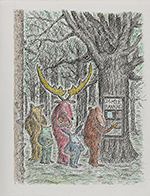
Edward Koren: The Capricious Line
The Bellarmine Museum
February 5, 2016 - April 8, 2016
Edward Koren: The Capricious Line is a major survey of the work of the artist best known for his cartoons and cover illustrations for The New Yorker magazine.This exhibition explores the full range of art that Edward Koren has produced during the past five decades: original drawings for cartoons and illustrated books as well as prints and independent drawings, many of which have never been displayed before. The artist's "capricious line" consists primarily of short strokes that create remarkably descriptive and expressive images. Koren's work brings us into the realm of fantasy based firmly in reality, such contradiction being one source of its humor.
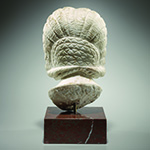
Hair in the Classical World
The Bellarmine Museum
October 7 - December 18, 2015
In most cultures hair is not worn in its natural state; it is artfully styled or dressed. Cut, combed, colored, curled, and shaped hair — that most universal of physical features — is also frequently adorned with implements or braids and occasionally, further embellished with pins, beads, and other decorations.
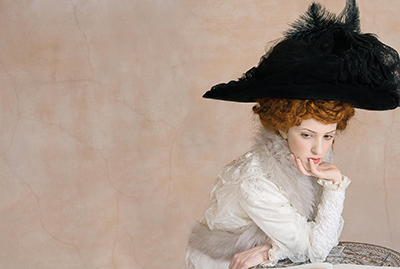
The Essence of Decadence
Thomas J. Walsh Gallery
September 19 - October 25, 2015
Italian artists Tania Brassesco (b. 1986) and Lazlo Passi Norberto (b. 1984) met as students in Venice in 2008. They have collaborated on several series of photographs that fuse their experience in performance, painting, set design, installation, photography and video. "The Essence of Decadence" is their first project together. The seven photographs, in which Tania appears as the model and artistic muse, reprise with uncanny fidelity the moody, poetic compositions of Gustav Klimt and other fin-de-siècle painters. Using the elastic, expressive and contemporary medium of photography, the artists painstakingly translate and reproduce with an almost surreal, magical verisimilitude the language of painting from another epoch. The result is a series of images that are hyper-real artistic fiction. This intriguing paradox is the essence of Tania and Lazlo's work.
This exhibition is organized by the Bellarmine Museum of Art and presented in celebration of the 25th anniversary of the Quick Center for the Arts of Fairfield University.
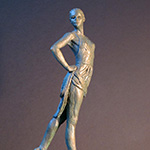
DANCE: Marc Mellon, Jane Sutherland, Philip Trager
Thomas J. Walsh Gallery
September 18, 2015-January 15, 2016
For more than five millennia, visual artists have been drawn to dance as a subject for their art-making. The ancient Egyptians, Greeks, and Romans all immortalized dancers - and their dances - in a range of media, including murals, vase decorations, cameos, and coins. Christian art, too, exhibited a marked fascination with the Bible's most infamous dancer, Salome, whose mesmerizing movements induced Herod to decapitate John the Baptist at her request.
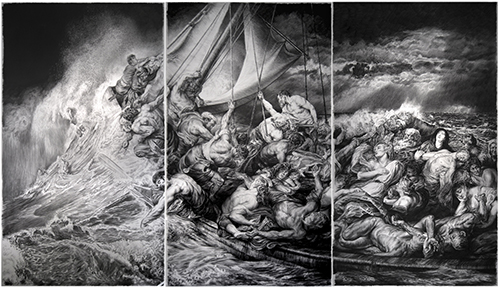
Rick Shaefer: The Refugee Trilogy
Thomas J. Walsh Gallery
September 8 - October 22, 2016
The Fairfield University Art Museum is pleased to present the inaugural exhibition of a monumental new series by Connecticut artist Rick Shaefer created in response to the ongoing refugee crisis convulsing the globe. This three-piece suite is comprised of Land Crossing, dealing with the migration across foreign lands; Water Crossing, addressing the perilous journeys of refugees who take to the open seas; and Border Crossing, spotlighting the hostilities refugees face in seeking safe haven far from a violence-torn homeland. The trilogy employs the artistic lexicon of old master painting (specifically incorporating heroic figurative elements from works by Rubens and Géricault) to explore this contemporary crisis in a language both familiar and iconic. Such historical allusions underscore the tenacious persistence of this epic human tragedy throughout time, past and present.
In addition to the three triptychs, each executed in charcoal on vellum, the exhibition will include a number of Shaefer's preparatory drawings for the series.
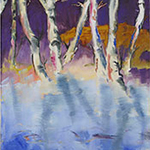
Jan Dilenschneider: Dualities
The Bellarmine Museum
June 4 - September 18, 2015
Connecticut artist Jan Dilenschneider finds much of her inspiration in the wondrous variegation of nature. Influences from Impressionism and Expressionism echo in her rich palette, loose brush strokes, and luminous vistas, while her affinity for landscape and the atmospheric effects of light and color link her to the venerable local tradition of landscape painting exemplified by the Cos Cob School that flourished a century ago. "I am greatly influenced by living on Long Island Sound, where many subjects lie within a mile of my home and studio," Dilenschneider has mused, "beautiful old trees, crystal blue water, elegant grasses, birds and great storms. I see a painting in everything: spring green leaves against bright blue skies, or misty trees that fade to blue-gray. The beauty of the world is my inspiration."
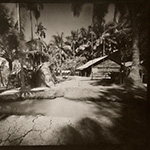
Ghosts in the Landscape: Vietnam Revisited
Thomas J. Walsh Gallery
March 26-June 6, 2015
Over a four-year period beginning in 1995, photographer Craig J. Barber, ex-combat Marine, returned to Vietnam to traverse many of his former military routes, making images with an 8x10-inch pinhole camera. In part a cathartic exercise, and a need to satisfy his curiosity about what had become of this once war-torn country, Barber created a series of 46 diptych and triptych panorama platinum images that capture the serene beauty of the country and, at times for him, the all-too-memorable landscapes. The tonality of the platinum process produces images with stunningly rich blacks and a full spectrum of delicately nuanced shades of gray.
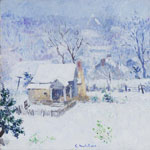
Gari Melchers: An American Impressionist at Home and Abroad
The Bellarmine Museum
March 5 - May 22, 2015
Hugely successful during his own lifetime, the Detroit-born artist Julius Garibaldi ("Gari") Melchers left behind an artistic legacy that is as varied as it is compelling. From engaging peasant scenes inspired by his years at the Egmonds, Holland (where he shared a studio with the great American painter George Hitchcock in the late 19th century) to intimate portraits of mothers and their children, Melchers' oeuvre is inflected with a dynamic range of influences, including the Barbizon School, Impressionism, and Symbolism.
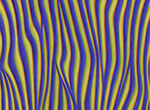
John Mendelsohn: The Passing Paintings
Thomas J. Walsh Art Gallery
December 2, 2014 - February 27, 2015
New York-based artist John Mendelsohn is best known for his remarkable work with color and pattern. This exhibition features 48 paintings from Passing, a cycle of paintings created by the artist during a 12-month period from 2010 to 2011. The cycle is comprised of five series of paintings -- titled Turbulence, Crosswalk, Vanishing, Flayed, and Paradise -- and while each series has its own character, each is also involved in states of change. The artist has written about these works that "Instability and dissolution appear in many forms; absence and presence are in continual dialogue.
The paint itself is treated physically: combed, marbleized, wiped off, and scraped away. As the paintings break down, they open up, revealing the surface and space beyond." The entire Passing cycle may be viewed online here. Mendelsohn's work in the Walsh Gallery will be complemented by seven more of his works, including a selection from the Six Movements series, which are on view in the lobby of the Quick Center for the Arts, adjacent to the gallery.

Rick Shaefer: Rendering Nature
The Bellarmine Museum
September 18, 2014 - February 7, 2015
Rick Shaefer: Rendering Nature features the work of Connecticut-based artist Rick Shaefer, who is best known for his remarkable works in charcoal on vellum. Inspired directly by the textural richness of the natural world as well as the communicative power of "the line," Shaefer gravitates towards subjects that are as visually compelling as they are intellectually engaging.
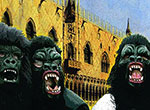
Not Ready to Make Nice: The Guerrilla Girls in the Artworld and Beyond
Thomas J. Walsh Gallery
September 4 - November 14, 2014
Not Ready to Make Nice, a major presentation of the Guerrilla Girls, illuminates and contextualizes the important historical and ongoing work of these highly original, provocative, and influential artists who champion feminism and social change. The Guerrilla Girls have been powerfully and consistently active since first breaking onto the art scene in 1985.
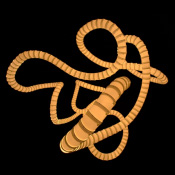
Jason Peters: Refraction
Thomas J. Walsh Art Gallery
April 24 - June 27, 2014
Fascinated by the destabilization of perception, Jason Peters creates illusory spaces and alternative realities through his work. Intentionally designed to trigger a cathartic sense of the sublime in his viewers, the artist amasses vast quantities of discarded objects from everyday life that he then reconfigures in surprisingly unexpected ways.
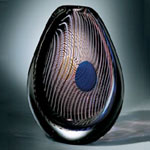
La Ragnatela/The Spiderweb: Works by Giampaolo Seguso from the Corning Museum of Glass
The Bellarmine Museum
April 10 - June 13, 2014
La Ragnatela (or "spider web") refers to the characteristically long, thin, lines and complex patterns of filigrana vases. A glass-making technique that was invented in 1527, filigrana consists of preparing parallel glass canes that are then melted into a mass of incandescent glass, creating perfect geometrical shapes in net and spiral-lie patterns.
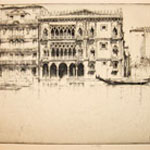
Reflections and Undercurrents: Ernest Roth and Printmaking in Venice, 1900-1940
Thomas J. Walsh Art Gallery
January 23 - April 4, 2014
Reflections & Undercurrents features prints by the German-born American painter and etcher Ernest Roth (1879-1964) and his contemporaries, including John Taylor Arms (1887-1953) and Joseph Pennell (1860-1926), exploring the connections between the art they made in early 20th-century Venice.

In the Wake of the Butterfly: James Abbott McNeill Whistler and His Circle in Venice
The Bellarmine Museum
January 23 - April 4, 2014
As a mature artist, the great American expatriate James Abbott McNeill Whistler (1834-1903) began using a stylized butterfly in place of a signature to maximize his work's aesthetic qualities. Whistler's concern with an immersive visual experience is highlighted in this focus show, which features works on paper from his Venetian series together with related images by Frank Duveneck (1848-1919), Otto Henry Bacher (1856-1909), Mortimer Luddington Menpes (1855-1938), Joseph Pennell (1860-1926), and Clifford Isaac Addams (1876-1942).
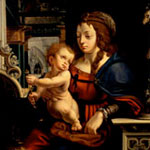
The Collectors' Cabinet: Renaissance and Baroque Masterworks from the Arnold and Seena Davis Collection
The Bellarmine Museum
October 10, 2013 - January 10, 2014
In the late Renaissance and Baroque periods in Europe, discerning burghers and aristocrats assembled encyclopedic collections of fine art objects, creating unique kunstkammern, or Cabinets of Arts. Arnold and Seena Davis have followed in this rich tradition, acquiring unique and beautiful works with a discerning eye and a curious intellect.
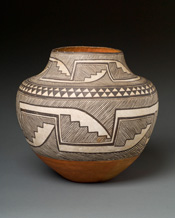
Fire and Earth: Native American Pottery from New Mexican Pueblos
The Bellarmine Museum
June 27 - October 3, 2013
First created nearly two millennia ago, Pueblo pottery is remarkable not only for its formal beauty but also for its cultural importance. Centuries after the Anasazi (or ancestral Pueblo people) first began making potted vessels from coils of tempered earth - rubbed smooth and painted with local clays, minerals, and vegetal pigments - their successors continue to do the same. An ancestral whisper, this knowledge was (and is) passed down from artist to artist, generation after generation, ensuring the survival of both ancient pottery techniques and the cultures that birthed them. Herein lies the beauty of objects whose value is truly much more than skin deep: They embody their creators' heritage.
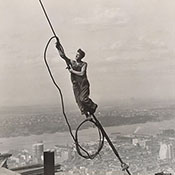
The Rise of a Landmark: Lewis Hine and the Empire State Building
Thomas J. Walsh Art Gallery
September 12 - November 26, 2013
American photographer Lewis Wickes Hine (1874-1940) documented the construction of the Empire State Building at every stage of the building of this New York City landmark, from its inception in the bedrock to its spectacular appearance on the Manhattan skyline. Fairfield University’s Thomas J. Walsh Art Gallery presents 51 of these engaging photographs, which do more than glorify the magnificent building; they speak to the integrity and courage of the workers who constructed it and explore the human condition in early 20th-century urban America.
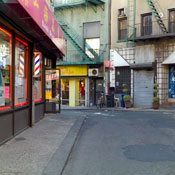
Excavation: Recent Photographs by Stanley Greenberg
The Bellarmine Museum
April 12 - June 14, 2013
[T]he city did not grow, as the economists taught, by quasi-natural laws, but was a willed artifact, a human construct in which many conscious and unconscious factors played their part ... [t]he principal document and witness to this process [is] the physical fabric of the city.
- Joseph Rykwert
As the eminent architectural historian Joseph Rykwert so eloquently reminds us in his The Seduction of Place: The History and Future of the City (2002), cities are wholly man-made constructs.
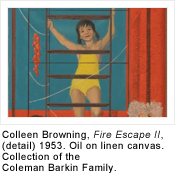
Colleen Browning: The Early Works
The Bellarmine Museum
January 24 - March 24, 2013
In collaboration with the Thomas J. Walsh Art Gallery
Remembered for her capacity to endow scenes from every day life with touches of "magic realism," painter Colleen Browning (1929-2003) is the focus of this monographic exhibition, mounted jointly with Fairfield University's Walsh Art Gallery. The Bellarmine Museum showcases Browning's early works on paper, together with several signature oils, while the Walsh displays some of her strongest post-1960s paintings.
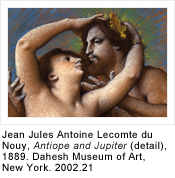
The Essential Line: Drawings from the Dahesh Museum of Art
The Bellarmine Museum
October 11, 2012 - January 18, 2013
This exhibition of works on loan from the Dahesh Museum of Art celebrates the act of drawing in the 19th century, when the creation of preliminary works on paper was the cornerstone of proper academic training and art-making. Embracing a broad range of subjects, the stunning pieces in this show are united by their creators' emphases on careful draftsmanship and extraordinary skills. Highlights include drawings by Thomas Couture (French, 1815-1879), Rosa Bonheur (French, 1822-1899), Frederic Lord Leighton (English, 1830-1896), Lawrence Alma-Tadema (British (born in the Netherlands), 1836-1912), and Alexandre Cabanel (French, 1823-1889).
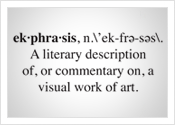
ekphrasis ii: sarah z. sleeper (mfa '12)
The Bellarmine Museum
July 11 - September 28, 2012
ek•phra•sis. n.'ek-frə-səs\. A literary description of or commentary on a visual work of art.
Holding the ancient technique of responding through the written word to visual works of art ("ekphrasis") at its core, this show provides an exciting platform for graduate students in Fairfield University's MFA in Creative Writing program. This year Sarah Sleeper (MFA '12) responds in prose to four works by Everett Raymond Kinstler, four works on loan from the Metropolitan Museum of Art and one piece in the museum's permanent collection.
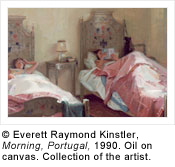
Everett Raymond Kinstler: Pulps to Portraits
The Bellarmine Museum
June 14 - September 28, 2012
Painter Everett Raymond Kinstler (b. 1926) sees the world in hues. Unfettered by conventional color designations, Kinstler paints his subjects as he perceives them, rather than as he knows them to be. His shadows, then, are neither brown nor black but instead pulse in shades of indigo and violet, while the artist's highlights dance unabashedly up and down the chromatic spectrum, from dusky peach to the palest of blues.

Immortality of the Spirit: Chinese Funerary Art from the Han & Tang Dynasties
The Bellarmine Museum
April 12, 2012 - June 6, 2012
For the ancient Chinese, life in the afterworld was as important as one's existence on earth. For this reason the dead were laid to rest in tombs intended to replicate earthly palaces in all their splendor. They were also adequately provisioned by surviving family members with mingqi, or "spirit articles," for the deceased's journey into the afterlife.
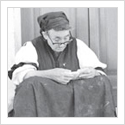
From Italy to America: Photographs of Anthony Riccio
The Bellarmine Museum
February 1, 2012 - March 30, 2012
For Anthony Riccio (b. 1952), a picture truly is worth a thousand words. For the past four decades, the New Haven, Connecticut, native has documented, in word and image, the experiences of Italians and Italian-Americans not only in Southern Italy - from Campania to Sicily - but also in two culturally rich immigrant communities in America, Boston's North End and New Haven's "Little Italy."
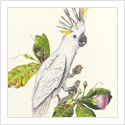
James Prosek: Un-Natural History
The Bellarmine Museum
October 21, 2011 - January 27, 2012
Artist, writer, and activist James Prosek made his authorial debut at age nineteen, when he was still an undergraduate at Yale University, with Trout: an Illustrated History (Alfred A. Knopf, 1996).

ekphrasis i: jeanne delarm-neri (mfa '12)
The Bellarmine Museum
June 15 - September 15, 2011
ek•phra•sis.n.'ek-frə-səs\. A literary description of or commentary on a visual work of art.
Poet and prose writer Jeanne DeLarm-Neri has created a series of new poems that respond to works in the Bellarmine Museum of Art's Permanent Collection. From a delicate 14th-century French ivory diptych to casts after masterworks from the Acropolis frieze, DeLarm-Neri engages with a broad cross-section of objects in the museum. In each instance, her writings give voice to a very personal aesthetic experience, which in turn provides visitors to the BMA with a new point of departure for their own interpretations and musings. DeLarm-Neri's poems will be displayed in the galleries next to the objects they address. They will also be posted on the BMA's website together with images of the relevant works.
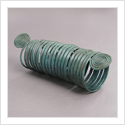
Kells to Clonmacnoise: Medieval Irish Art in Context
The Bellarmine Museum
April 18 - May 24, 2011
This exhibition highlights the University's facsimile of the Book of Kells, and four reproductions of Irish medieval metalwork on loan from the Metropolitan Museum of Art's Department of Medieval Art and The Cloisters. The Book of Kells is a lavishly decorated Irish gospel book, which contains colorful decorations on each calligraphic page, including several full page illustrations.
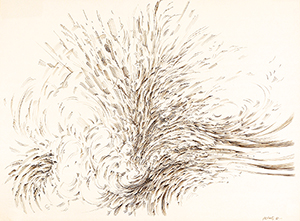
Norman Gorbaty: Works in Dialogue
The Bellarmine Museum
January 27 - March 27, 2011
Over the span of his fifty year career as a graphic artist, Norman Gorbaty has produced a formidable body of work, including sculptures, paintings, and works on paper. A master of abstract empiricism, the artist's work is a testament to his pursuit of pure forms through observation and movement. Using emptiness as a symbol and minimalism as a style, Gorbaty transforms spaces into an evocative blend of mystery, freshness, and beauty. Works in Dialogue will run in tandem with Gorbaty's show of Judaica at the Thomas J. Walsh Gallery (To Honor My People), and will highlight the artist's smaller works on paper and his carved "stele."
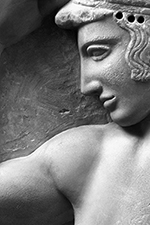
Gifts from Athens: New Plaster Casts from the Acropolis Museum and Photographs by Socratis Mavrommatis
The Bellarmine Museum
November 2 - December 17, 2010
This exhibition highlighted photographs by Socratis Mavrommatis, a prominent Greek photographer who gifted 23 works to the university in 2008, and 8 new plaster casts, given by the Acropolis Museum in Athens to Fairfield in July 2010. Mavrommatis's work focuses on the Acropolis, with an emphasis on the beauty and changing nature of monuments and the Athenian landscape. The plaster casts, in contrast, are evidence of the grandeur and monumentality of the Parthenon and other Acropolis sculptures, and remain symbols of the art and mythology of Ancient Greece. This show also explored Athenian "gifts" in the broader sense - that is, of antiquity's enduring legacy in the development and evolution of Western civilization's multi-faceted culture.
Scroll to Learn More